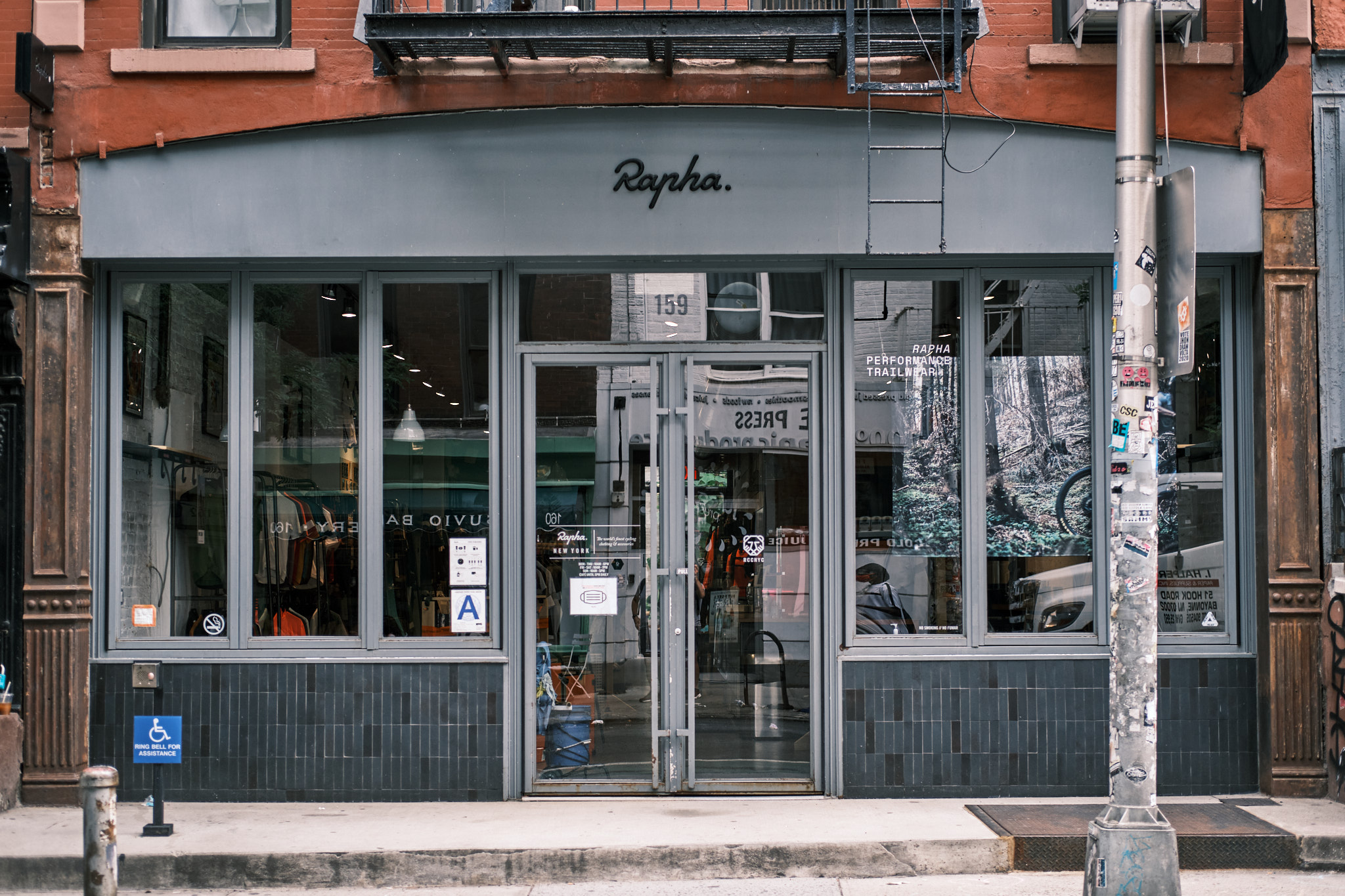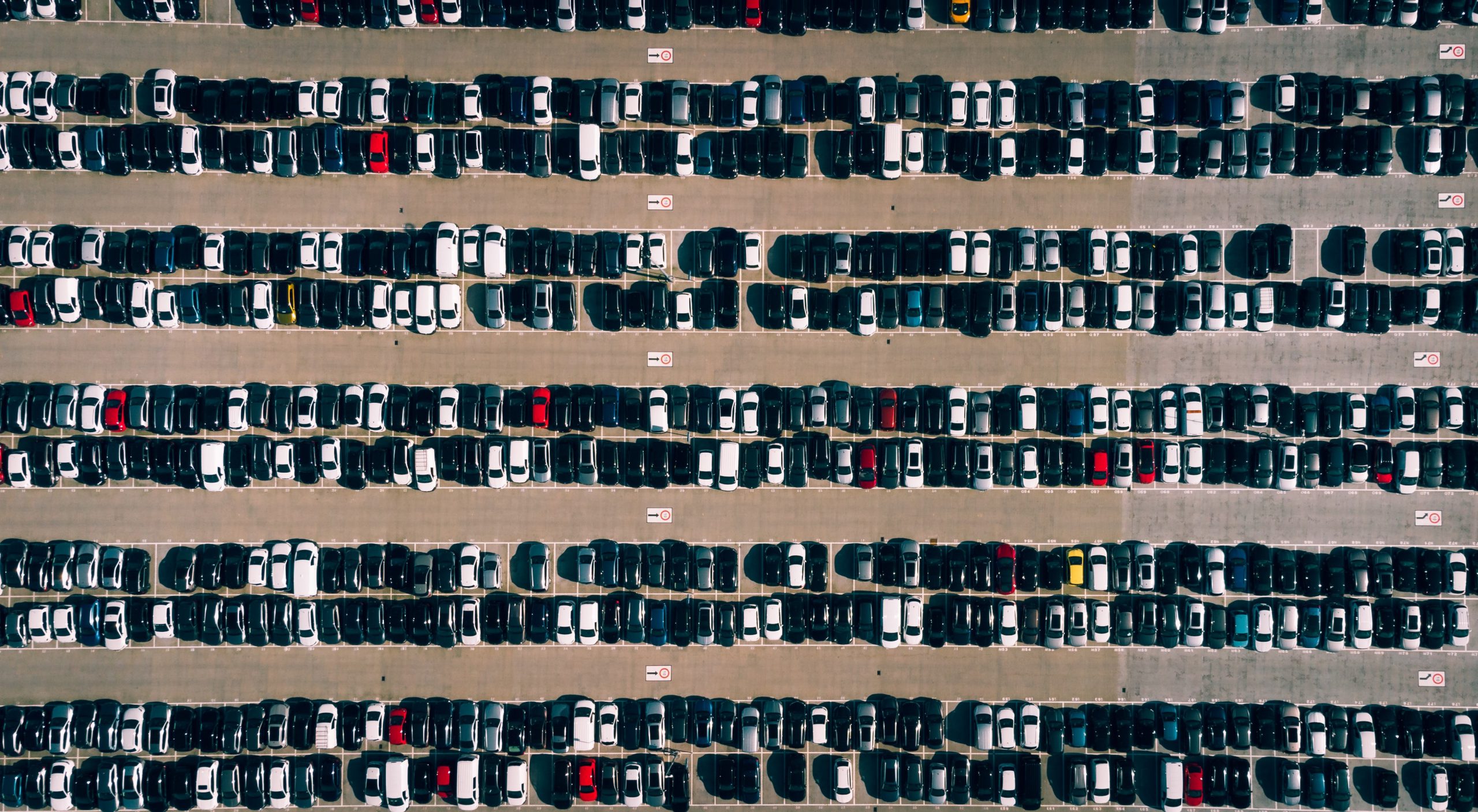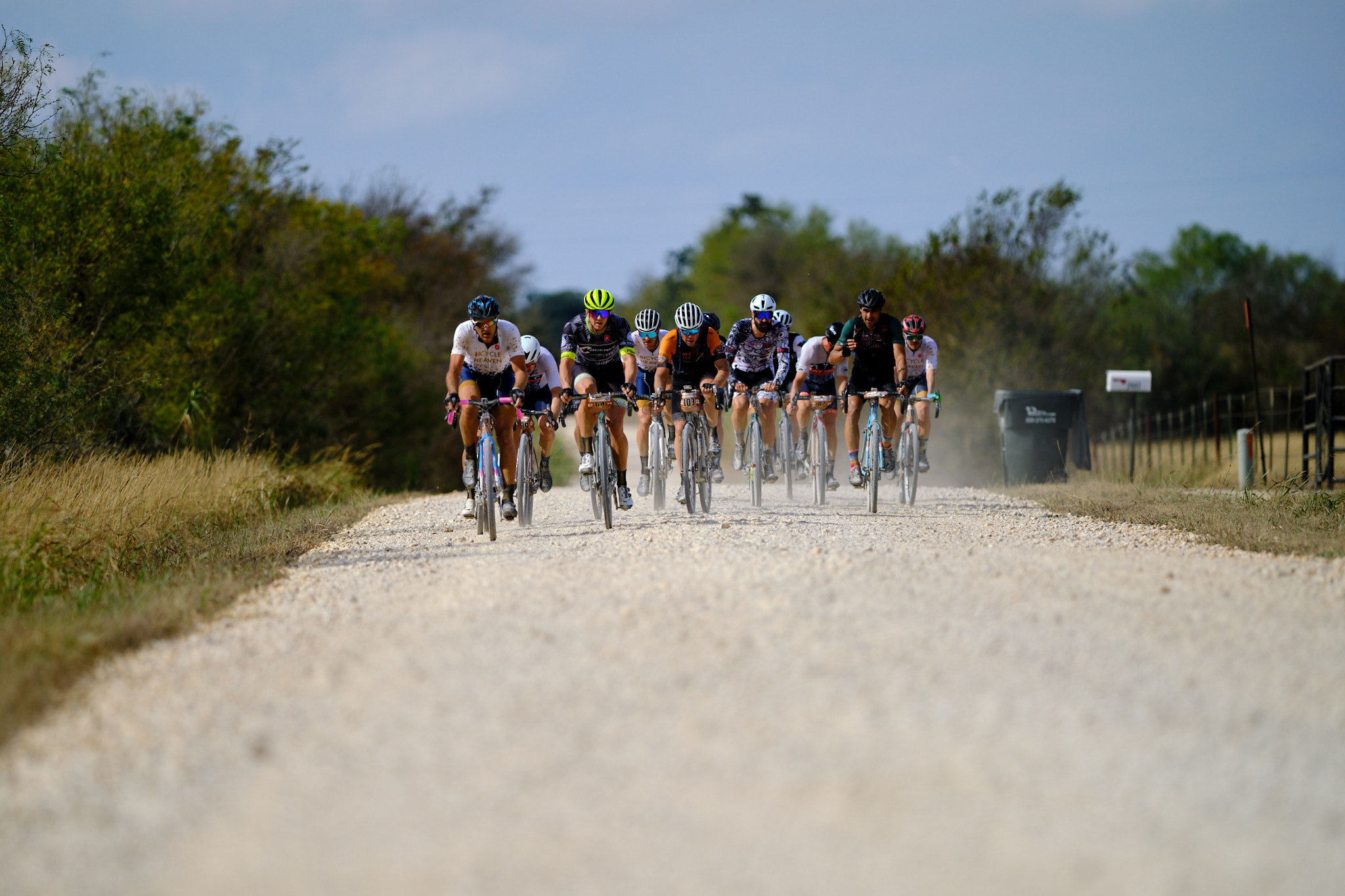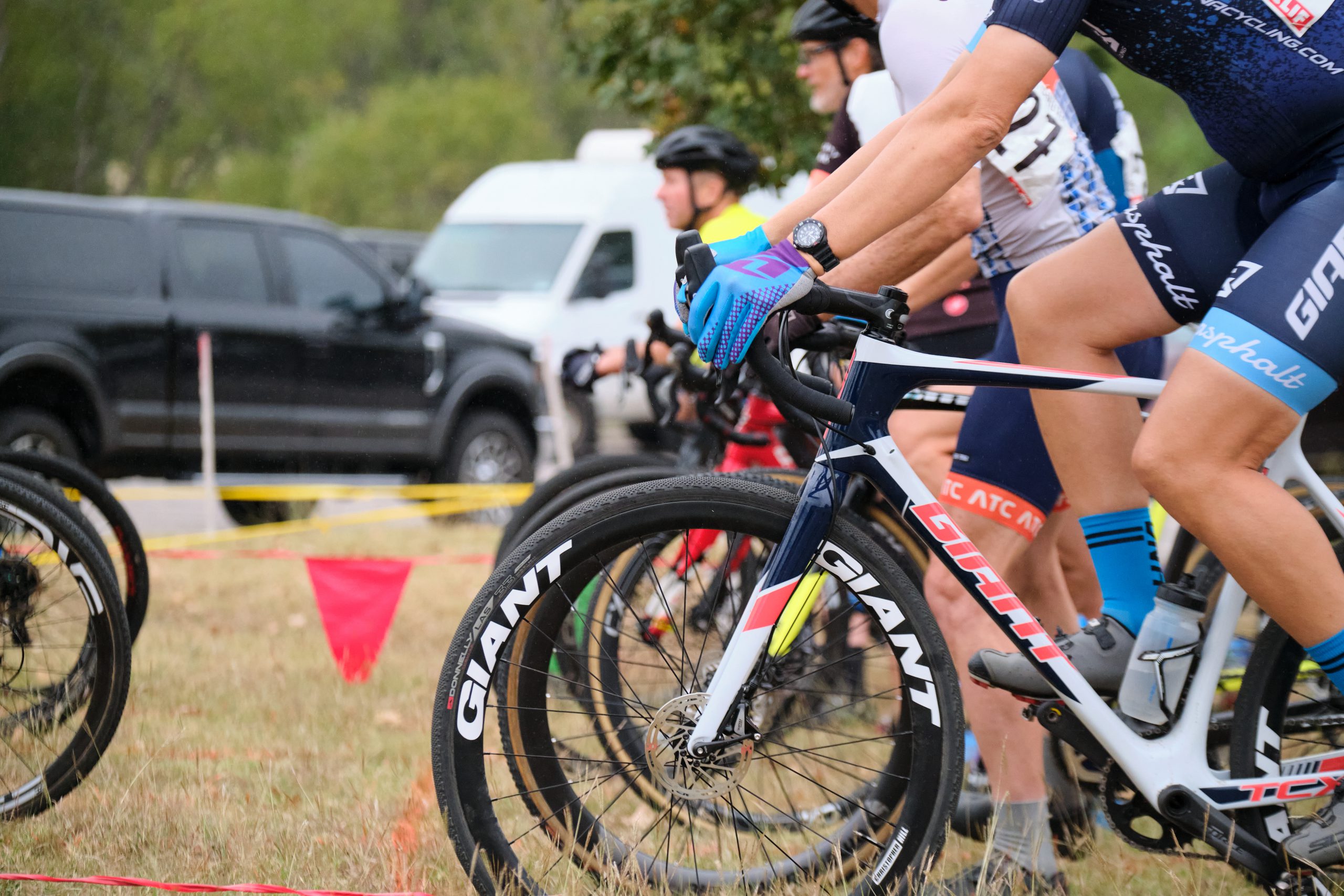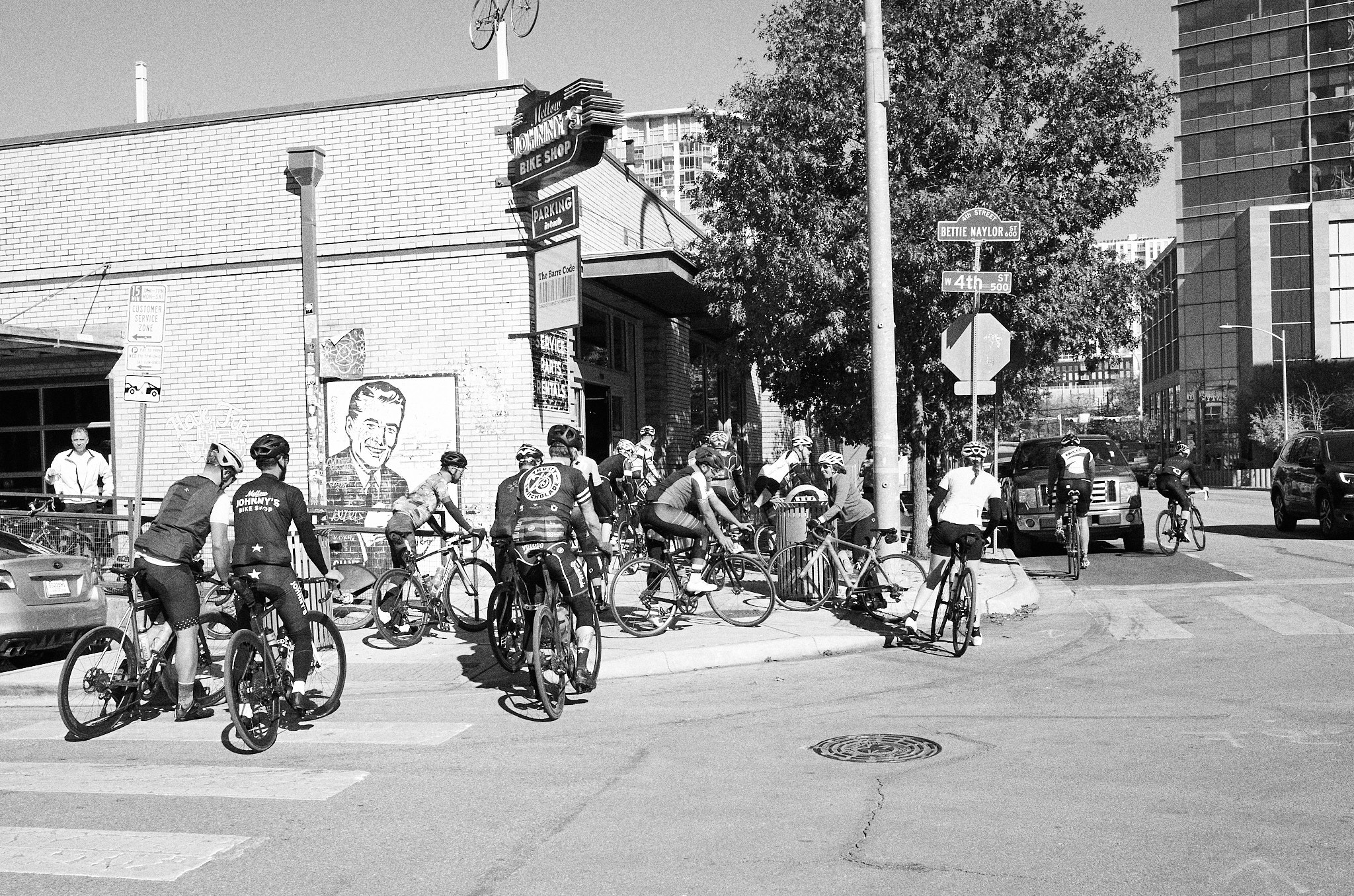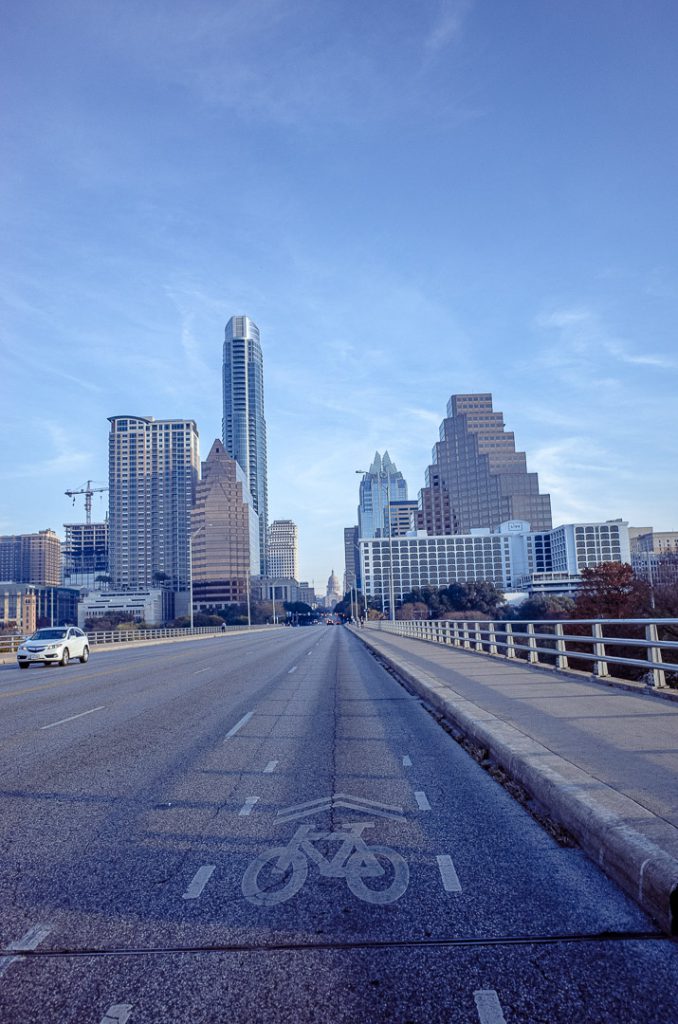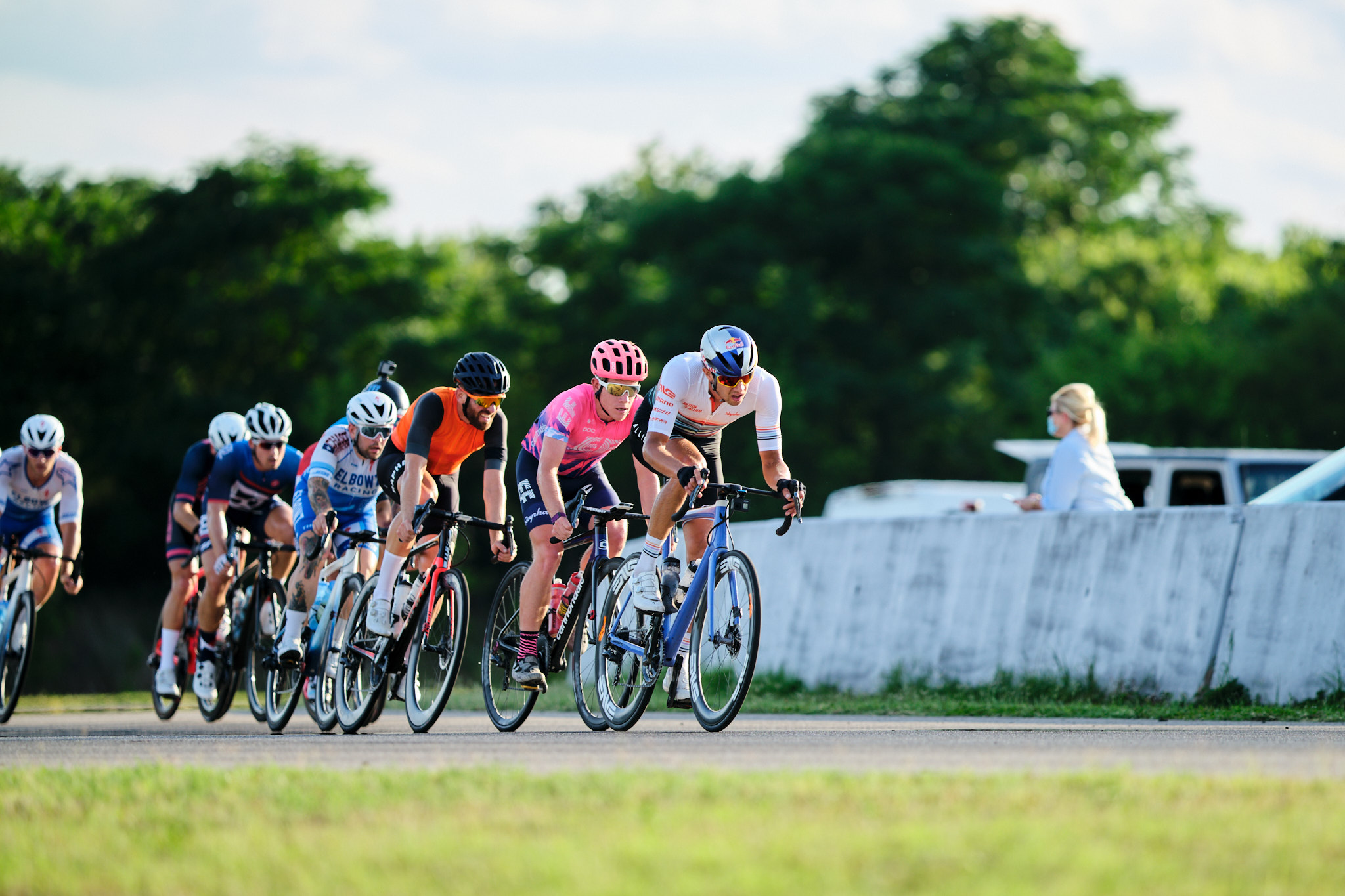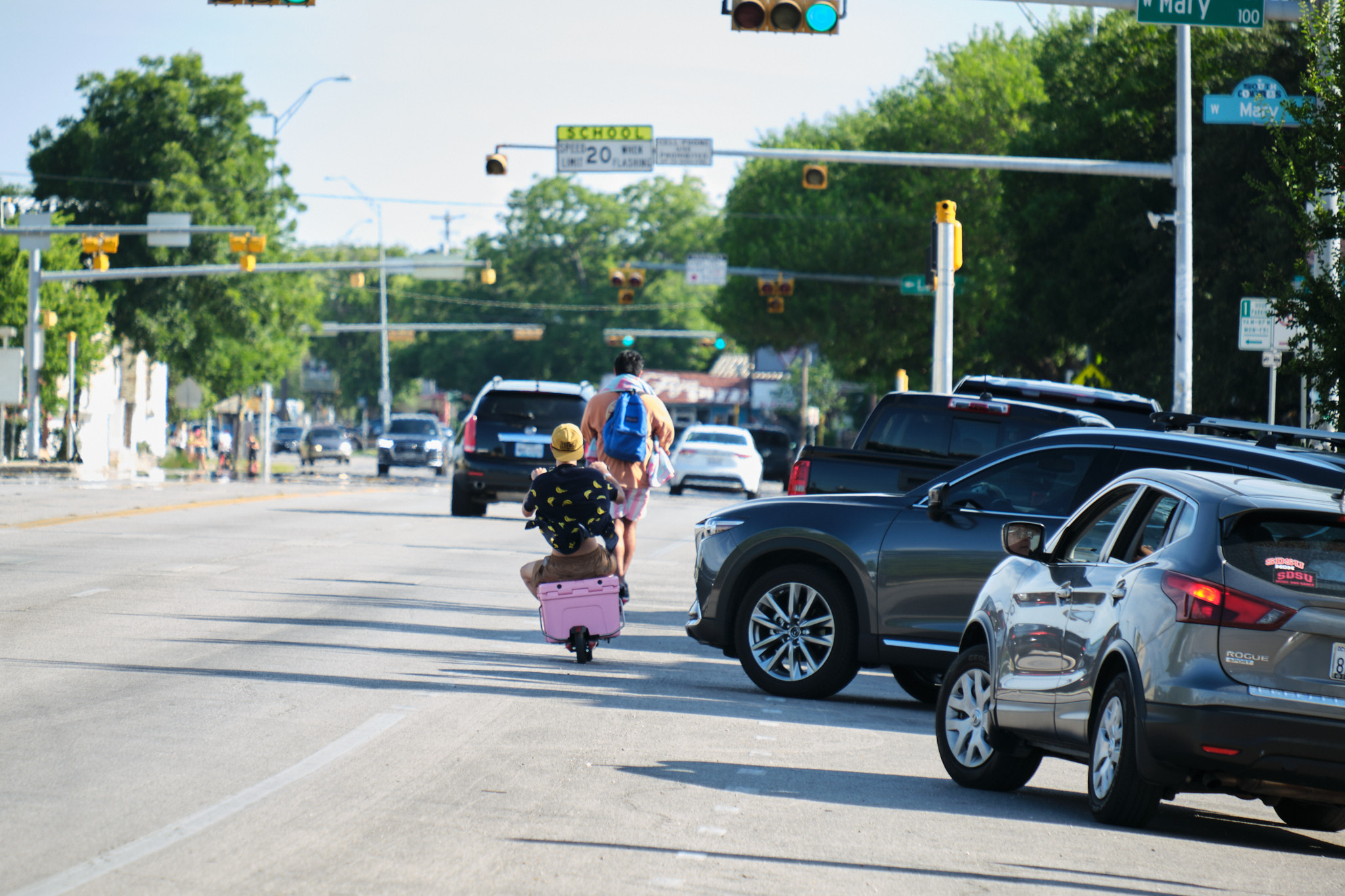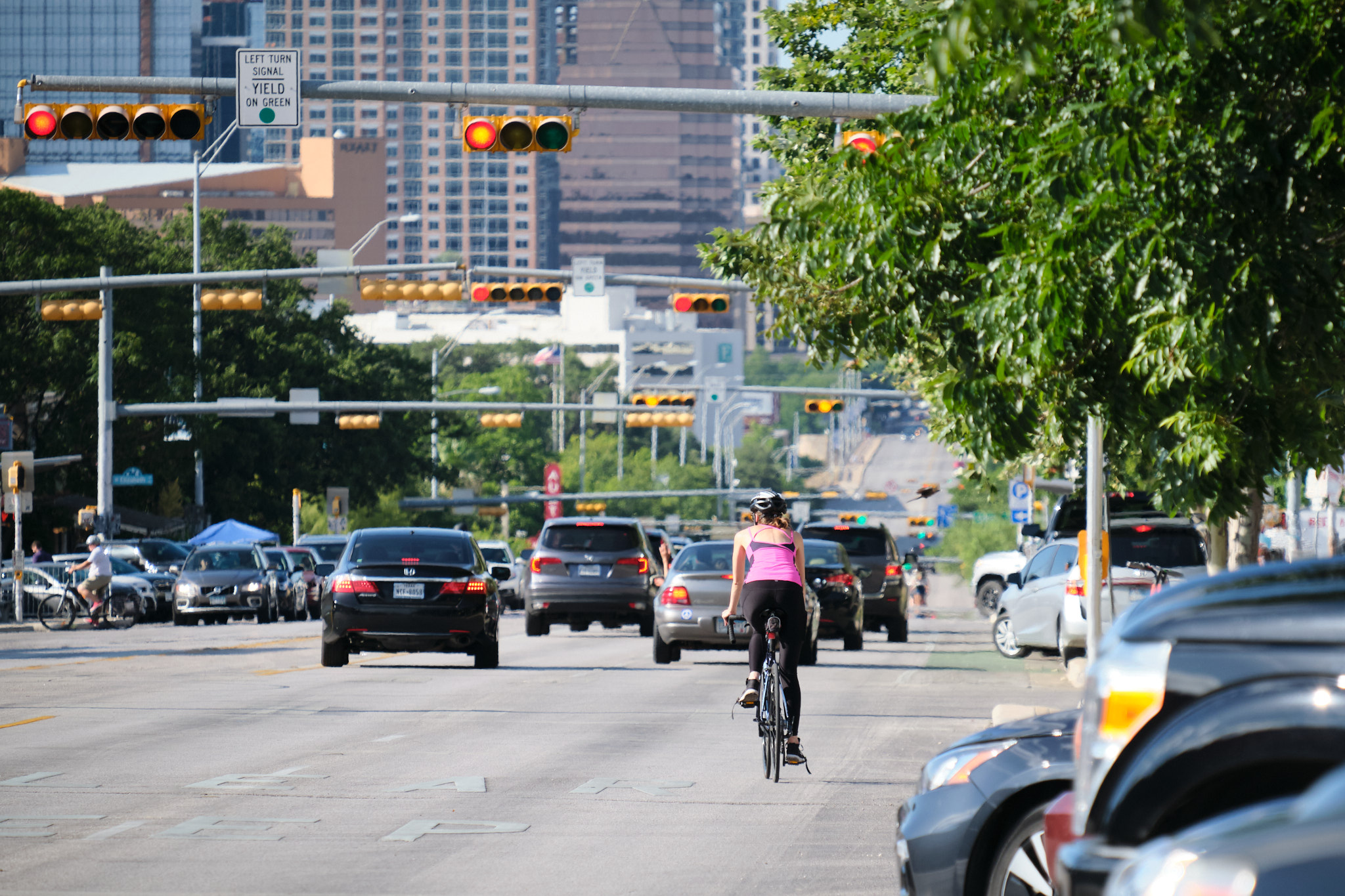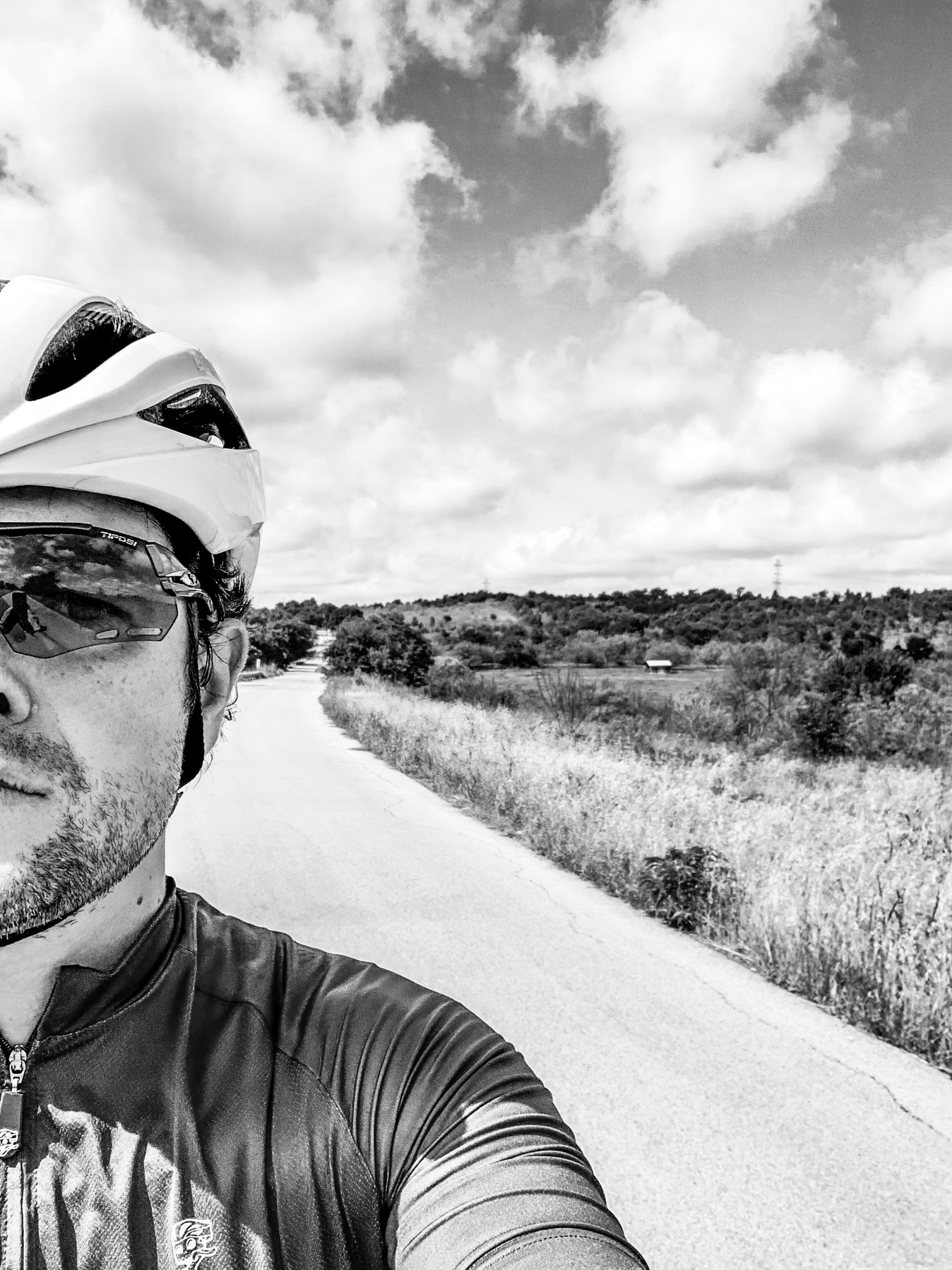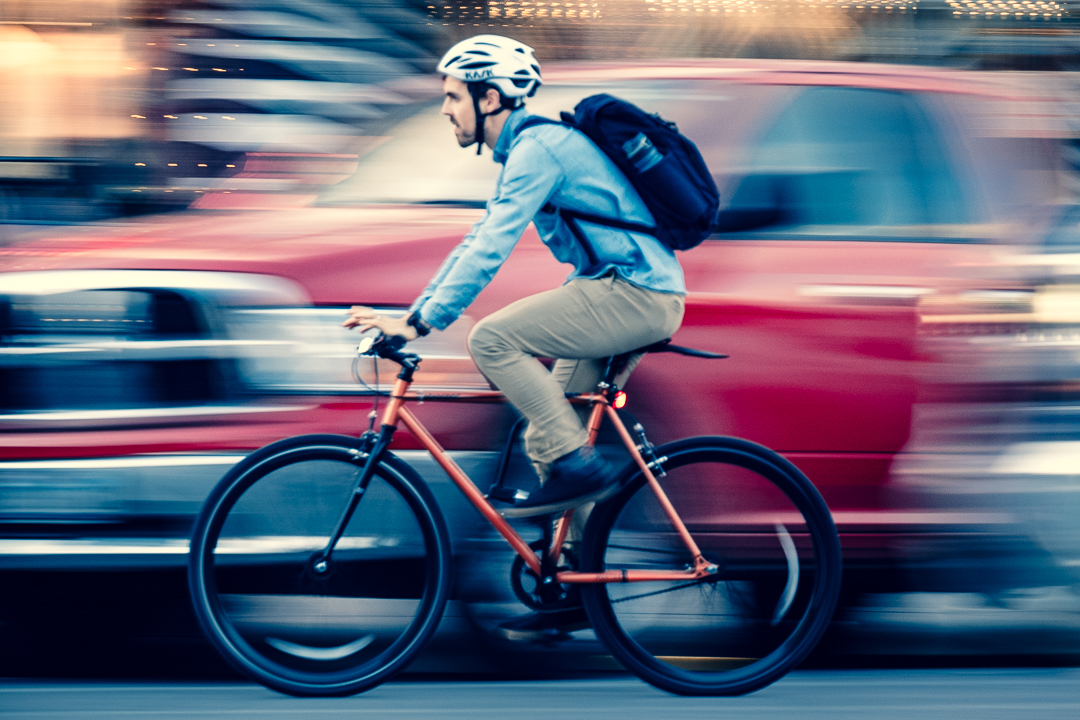Are Roadies Vapid?
Can you feel it? That pressure to whip out the smartphone for the fifth time on the Saturday ride to document your humorously childish store-stop candy selection? Or to humblebrag your finish at the Tuesday Nighter? Or maybe just to rep your club? #WeOutHere, right?
As my involvement with cycling deepens, so too does an awareness of the unceasing sharing of any situation that might bolster the social proof of one’s belonging to the cycling community (or maybe “scene” is a more appropriate word here), especially roadies. On weekend mornings, we hop on multi-thousand dollar bikes wearing hundreds of dollars worth of carefully curated clothing, often displaying affiliation with a team or brand. The people with whom we meet closely match us in education, income, preferences and ethnicity. Off we go into the countryside, each equipped with a smartphone capable of capturing and sharing one’s own narrative interpretation of the experience. There’s nothing wrong with this per se, but it sometimes feels like the ride has become almost secondary to the production of likes and follows.
To me, frequent brand mentions are the most suspect. When was it decided that providing free advertising for brands of interest was an aspirational behavior? Do I need to shout out to the manufacturer of my gels, shoes, bike, etc., after each use? Actually, this has been going on for a long time in one form or another, but aren’t we moderns more self aware than that in 2021? What if I want to go to the bike shop or have a coffee without spewing @s? “Want to” isn’t even the issue. Can I resist the urge to do so or has my iPhone completely hijacked my brain?
The life and career success of those I sometimes meet on group rides is amazing. Degrees from top schools and high-status professions are common. I recall listening to two acquaintances deliberate about WWII politics for the duration of a long group ride and, often, the jokes go right over my witless head. Another riding friend will soon be off to MIT to teach mathematics. Shouldn’t, then, our sharing lean more toward the realm of ideas? Perhaps the insights gleaned from overcoming adversity on the bike, or the beautiful scenes through which we glide? I do see some of this but, even then, it’s often marred with declarations of product allegiance.
As a previously avid runner, putting on my shoes and heading out for a “little journey”, as I often thought of it, along my favorite routes was a joy. There was simplicity in this and an opportunity to be with my thoughts. The iPhone stayed home, so natural beauty or interesting cityscapes seen along the way were transient pleasures only to be revisited in memory.
Now in the cycling world, I find myself scrolling endlessly, looking at products I can’t afford, experiencing FOMO about rides and events, and an inadequacy about racing fitness I can never achieve. The prevailing narrative of running-Instagram seems to be “isn’t this great?!”, while cycling channels communicate “aren’t I great?!” and “buy this thing!”. It can be crushing when approached with the wrong mindset.
Admittedly, much of what I see is still quite motivating. On days that I’m not quite feeling the vibe of spending hours in service of my two wheeled machine, these posts provide enough inspiration to get me out the door (or on the trainer). If they’re doing it, I can too, right? Social media is also one of the best ways to discover group rides, events, places of interest, etc. — all the things that keep riding exciting.
Cycling also seems to attract a grittier and more competitive crowd. Not that runners aren’t a tough bunch, but bikes, by their nature, are extremely efficient machines. Achieving high fitness is impossible without a huge time commitment. Putting up with the long hours of training, financial burden, injury, and self-imposed suffering takes a special kind of person. In enduring such things, I think a certain pride develops, a feeling of having reaped a reward and, with that, the desire to show it off.
I don’t recall being frequently honked at, given the finger, singled out by police and politicians, misunderstood by anyone operating a motorized vehicle, or hated on in Twitter/FB comments as a runner (except for bros shaming runner bodies), but all these things are a matter of course to the devoted cyclist. Putting up with it all engenders a sense of camaraderie in this niche community that strengthens the desire to share and signal one’s belonging.
And, if I’m honest, many of these over-sharers are pretty darn impressive people. High level amateurs put in what almost amounts to a second full-time job, while also maintaining successful careers and family lives. The completeness of their involvement in the sport is inspiring. Brands and businesses I follow are both the nodes around which the cycling community congregates and success stories in this incredibly difficult business.
Of course, we can’t forget racing. Bicycle races are part athletic achievement and part performance art. Managing one’s fitness, equipment and team, and having it all come together on race day is an achievement that deserves to be shared. The brands and businesses that help make that achievement possible, in so doing, earn the admiration (or contempt) of their customers.
So, are cyclists vapid? It often feels that way but, despite my social media fatigue, I don’t think so. While the posts in my feed often feel ostentatious, the truth is that these people ARE doing something awesome and I AM missing out. This fringe, dangerous, beautiful sport needs to look as cool and rewarding as possible if it’s to survive in the US, and every small brand, team or lone wolf destroyer of pack sprints should continue to generate as much admiration and desire in the cycling masses as they possibly can. We need you, oh #break40 crit racer, oh #bikepacking adventurer, oh “master’s elite” gravel grinder. Feel no shame, and post your experiences in the saddle whenever the muse strikes.
I Bought a Car and Feel Terrible About It
If I'm honest with myself, embarrassment deserves partial credit when considering the reasons that I first sold my car. In my defense, values about transportation and housing policy were ultimately the deciding factor. For the previous two-ish years, I had been getting around Austin primarily by bike. The car simply sat there, accumulating maintenance and insurance expense that could be spread to various other modes of transportation.
When I finally worked up the guts to get rid of my "friend," as I thought of it — a beat-up (very) but reliable 2005 Honda Accord —it was a quick breakup. A scammy guy showed up within two hours of my long-winded Craigslist ad going live (that I'm sure he didn't even appreciate), and convinced me to let him drive away with an open title (a practice my naïveté left me unaware of at the time). Aside from worrying if my now unregistered vehicle would be used to rob a bank, I was finally free from the burdens of car ownership.
Transportation then became a multi-modal buffet of bikes, busses, trains, Ubers and rental cars. This method wasn't necessarily cheaper but seemed to offer a certain kind of freedom, in addition to allowing me to pay upfront for transportation expense rather than hiding it away in creeping depreciation, future auto maintenance bills and bi-annual insurance payments. For the most part, travel was either an enjoyable experience ("the journey is the destination" by bike, after all), or a stress-free trip handled by someone else (Uber, bus, train). Things were working out swimmingly, then Covid happened.
As of this writing, the virus is only just beginning to wane. It's still too recent for me to understand just how I'll look back on it, but I suppose it might be thought of as something like "the time when everything stopped". With businesses closed and not many people moving around, many of my mobility options dried up. Sure, the bike was always there, but bus service slowed to an unusable crawl and the many scooter and e-bike shares around Austin were removed, allegedly to stop the spread, though probably for liability reasons (let's not pretend these companies care about your safety).

The feeling of isolation so many have written about over the past year set in, and I found myself wanting to "escape" or "get out of here". Escape what? At the time, I wasn't sure, but it seemed like a car was the way to do it. Looking back, the thing I wanted to escape was my own head, and pouring over AutoTrader and the minute details of different vehicles was my outlet. This behavior has occurred enough times in my life that I can recognize it, but only after the fact. When in the grips of this escapism, the thoughts seem entirely rational.
Over a month of looking finally revealed the type of vehicle I wanted: Something reliable, technologically simple (older) and ordinary (I know, aren't I exciting?). The winner was a 2011 Toyota RAV4 for sale an hour away in San Antonio.
Finally, a car. I was "free”, or so I thought for a day or two. Even with a car, it was soon revealed that there was still nowhere to go and, now, in addition to the cost of the car, I had $800 in taxes to pay, $700 for annual insurance and a $400 maintenance bill. These expenses, plus the down payment, covered what would have previously been an entire year's worth of transportation expense. I fell for my irrational purchase escapism and paid the price.
Sure, having a car is convenient, but by living without one in a city like Austin, you quickly realize that the drawbacks are overcome relatively easily. Even considering the gross lengths we go to as a society to make driving as easy as possible, one can get around reasonably simply with a bit of planning and slightly more effort if the location of one's housing is wisely selected. With this in mind, every trip in my new ball-and-chain is marred with the knowledge that "an e-bike would have been perfect for this" or "a ten-minute wait would have allowed me to make this trip by bus", each alternative scenario costing hundreds or thousands of dollars less in the long run.
In the first month of ownership, I tried to sell the car, and even found a potential buyer. However, the reality of my sunk costs was undeniable: The price of keeping it was lower than selling and returning to my previous modes of transportation, making the sale a purely ideological decision. Ultimately, I chose conformity and convenience over values.
Does the car have its benefits? Sure. I sometimes see it as the ultimate cycling accessory. I can travel to any event or perhaps a far-away ride without consideration of how I'm going to get there. In the past, this was usually via rental cars, which aren’t always available. With a new gravel bike, I can drive out to the countryside and start new routes in spots I would previously have had to ride for a couple of hours to reach. This summer, I'll drive nine hours to participate in Unbound (formerly Dirty Kanza) and maybe also do some riding in West Texas. These decisions are made all the easier when transportation planning requires little more than a stop for gas.
At the same time, these drives are a reminder that the prevalence of the automobile is the reason it takes so long to reach anything that resembles the countryside. Between home and nature are miles of highways and sprawl, full of gas stations, big box stores and McMansions. Some places in the world manage to keep their cities dense enough that a short train trip or bike ride is enough to reach more rural settings and, once there, communities that are more accepting of cyclists. This is far from the reality of life in Texas.
Some places in the world manage to keep their cities relatively dense, allowing rural settings to be reached quickly by train or bike. These places also seem to be more accepting of cyclists. Sure, my small hometown has plenty of countryside, but I’ve probably been honked at there more times than I have in Austin.
So, was it worth it? No. For me, the costs and responsibility of car ownership outweigh its benefits. The "lost year" is coming to an end and with it a return to the normalcy of my previous transportation options. I write you from a bike shop where I've just picked up a bike from a tune up. In the past, I would have taken a scooter here and ridden the bike back — to me, a more gratifying and fun way to travel than firing up my 4,000 pound cage.
Shooting Gravel Events
It would be presumptuous to claim much lived experience in the area of photographing gravel cycling races, yet each passing event provides a few lessons that improve my ability to arrive at the place I need to be at the time I’m supposed to be there. To organize my thoughts before an upcoming event, I thought I'd share the strategies I've established thus far.
An important characteristic of American gravel events from a photography standpoint is that, rather than traversing mountainous terrain with few throughways in the style of a European road race, the course typically forms a loop made up of gravel lanes bisected by numerous paved roads and state highways, so while it’s difficult to drive over the course much faster than the quickest riders themselves, especially when trying to pass them on narrow dirt roads, these highways serve as quick transportation between various photo spots along the way.
Assuming an average speed of 20mph for the front group, one can travel to three or four locations on a shorter course (with time to set up between) without covering riders in road dust.
Here are three representative courses. All are in different parts of the country, but follow the same basic pattern:
Bull Grind: A shorter event outside Austin, TX - https://ridewithgps.com/routes/33124238
Dirty Kanza 2018: One of the largest gravel races in the US (now called Unbound). Emporia, KS - https://ridewithgps.com/trips/23860354
Barry Roubaix 2018: A popular even in northern Michigan - https://ridewithgps.com/trips/22333636
Planning
For high-level professional work, I suppose a dedicated GPS with pre-programmed points would be ideal for navigating an event. In my case, I’m simply using a phone and Google Maps. Are you familiar with Google’s My Maps product?
My Maps allows you to upload and annotate course .gpx files and then navigate to points along that route. If a course has, say, 30, 60 and 90 mile events, each can be uploaded and simultaneously displayed to determine where the courses diverge. My hope is to take photos at three or more points: One that catches all three groups, two that the mid-distance group will cross, and one final point that will only see the main event, plus the finish. Even if the front group is missed at the finish, it’s easy to poach stragglers once you finally make it back to the starting point.
Planning on desktop:
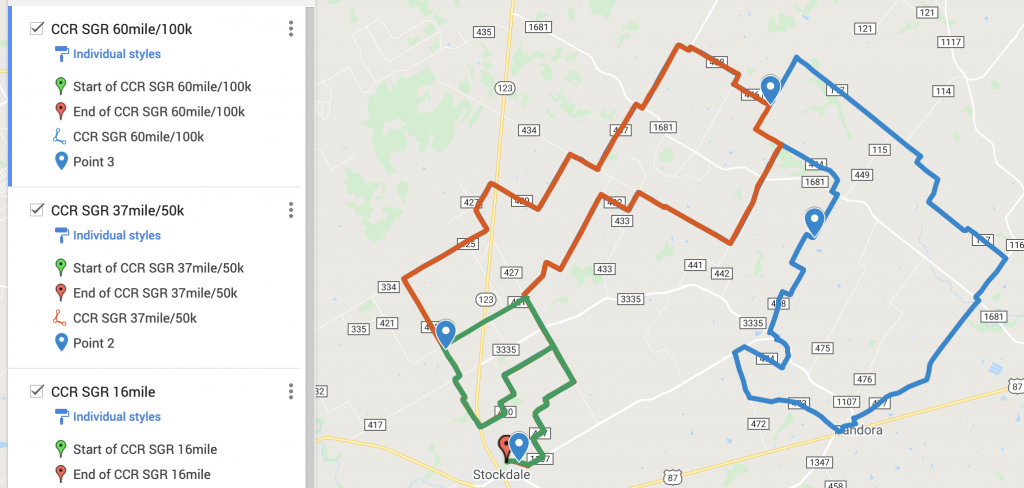
Unfortunately, My Maps doesn’t include Street View, which is an important part of selecting the most attractive spots if you won’t be pre-riding or driving the course. My solution is to keep the course open in RideWithGPS.com, where changing the map style from “RWGPS” to “Map” will enable the draggable Google Street View marker (though many of these remote roads won’t have Street View available). Alternatively, creating a point in My Maps and copy-pasting its coordinates to Google Maps also works.
I look for hills, curves, beautiful countryside and, of course, gravel. Riders want to be photographed looking like Colin Strickland and not Team Ineos.
Timing
Average speeds vary widely in an open gravel event. Unlike road races, where licensed riders are participating in their designated categories and traveling in a fairly compact group, gravel events are fondo-style, with both “racers” and “riders” in the same event. Remember those math puzzles from your SATs: “If two trains leave the station at…”. Who’d have thought you’d ever actually use that stuff? Well, it’s helpful here.
With a big speed gap, the first and last riders can already be 20 minutes apart only ten miles into the race and, when that final rider passes, the front group will already be 7 miles up the road, which could be almost half way to your next point — a 20 minute drive. Timing is important.
The first point along the course should be relatively close to the start if you hope to catch most of the field before moving on, perhaps ten miles in or less. If the race has a neutral roll out then you’re in luck, as this will slow things down a bit as you make your way out onto the course.
I use 20mph for the front group and around 12mph for the stragglers on the short route, and closer to 14-15mph for the mid-pack riders on the longer courses. This isn’t perfect and varies with terrain and gravel-chunkiness, of course, but uses time efficiently. The reality is that you can’t wait for everyone. I’ll figure out the spread between the front and rear of the field and write down estimated times, and then update them with actual times and speeds as the event progresses. Even made a spreadsheet for it:
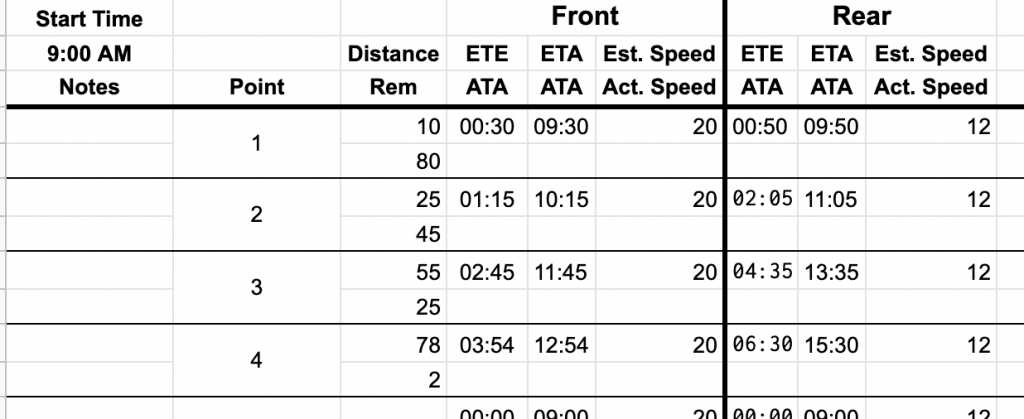
Realistically, the wait time will increase over the duration of the event unless you’ve got a compact course (or are a fast driver) and, eventually, the stragglers will be too far behind to wait. In the image above you can see that the last riders are crossing Point 3 well after the front group has reached Point 4. I have yet to devise a strategy for handling this over the massive distances of some gravel events, but maybe 2021 will present opportunities to experiment.
Positioning
I certainly haven’t mastered the art of positioning myself for the greatest variety of shots. The top World Tour photographers do an incredible job here, and the diversity of their photos is amazing (see Jered Gruber’s work). Of course, their role is more that of documentarian, while I’m trying to get varied shots of as many participants as possible, which can subsequently be purchased for #lightbro use on the ‘gram.
As previously mentioned, areas with hills, curves, beautiful countryside and gravel help create the money shot. The best spots present two completely different scenes in each direction. Even better if it’s also a place where riders double back after a loop. Curves are great because you can photograph the field in different settings with a short walk, or catch the added dynamism of riders taking curve.
These two photos were taken on opposite sides of a curve where riders were also doubling back:
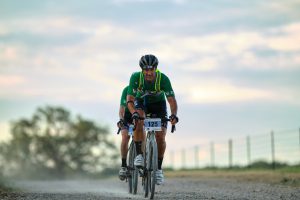
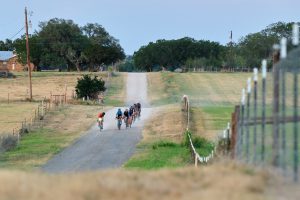
Getting into position can be a little anxiety-inducing, as once “they’re off!” so are you. And if you don’t know what you’re doing, then you’re going to fail at the job you came to do. Have an idea of where to park for a fast escape after the start of the race, and DO NOT try to drive the course. You won’t be able to pass the mass of riders (ask me how I know).
After taking photos at the start, I’ll rush to my car to navigate to the first point. With the timing and points already worked out, this is easy. I simply open My Maps, choose the first point and drive.
Unpaved roads often also mean poor cell service, so I download the map area onto my phone ahead of the event.
Equipment
Though my current setup may change, I’m happy with the results I’m getting using my Fuji X-T3 with the 50-140mm (~70-200mm equivalent) f2.8 lens along with the 200mm (~300mm equivalent) f2 prime, which I rent (because it’s $6,000!).
Fujifilm cameras aren’t necessarily designed for sports, however, for the price, they're an accessible tool for the job. The autofocus works well and with everything set up correctly my miss rate is relatively low. Some other features of this system are also great for sports:
- Pre-Shot AF - When pre-focusing on a subject, photos go into the buffer before the shutter is pressed. When the shot is taking, these “pre-shot” photos are saved to ensure you’ve captured the critical moment. Note: This only works using electronic shutter.
- 11fps with mechanical shutter. This is plenty fast for my purposes, as I’d rather not fill my card with thousands of throwaways. Still, with electronic shutter and a slight crop called “sports finder mode”, the camera can shoot up to 30fps.
- Cost. Sure, I’d love to have a Sony A9 or Canon 1DX for sports, but they’re expensive AF. Fuji offers a versatile system for a good price.
Settings:
Continuous autofocus (AF-C) is the tool designed for the job, and that’s what I’m usually using for action shots. Single (AF-S) can work well for slower moments or wider depths of field, and I appreciate the ability to recompose shots using AF-S. At f2 with a cyclist moving toward you, though, there’s no time to recompose as they’ll be out of focus almost instantly (see "Depth of field in front" with different numbers here). Different compositions can be achieved with AF-C by moving the focus point, but there’s no saying what framing will look best when the peloton comes through. For this reason, I usually just go for center-of-frame and crop later.
As to whether to use zone focus or not, it really depends on the situation. With bunches of riders, I prefer the single focus point for the ability to select individual riders in a bunch. Zone tends to jump around and sometimes feels like guesswork, and I much prefer the tighter control of selecting who’s in focus. On the other hand, zone works much better with individual riders as it’s more likely acquire focus and track the subject.
Another issue with zone focus is that if it locks to a rider's shoulder, wheel, handlebar, etc., the face will be soft at an extremely shallow DoF. The Fuji 200 f2 is beautiful, but can be tough to work with when shooting wide open.
What AF-C custom settings are best using zone focus? I have no idea. I’ve experimented with preset 1 and 3, and currently have a custom setting of Tracking - 2, Speed Tracking - 1 (both the middle settings). I don’t rely on tracking much and, perhaps foolishly, attempt to command the camera to focus where and when I want it.
The use of electronic shutter is sometimes cautioned for action shots, as movement can cause a rolling shutter effect. I have yet to notice this in my action photos, and some of my best shots were taken with electronic shutter. In fact, the Pre-shot ES setting actually requires it. This setting keeps images in the buffer and then saves them once you press the shutter, effectively giving you 20 more captures before the decisive moment. This is significantly more frames than I want to sift through, so I typically leave it off except for the most critical shots.
Back Button Focus is another technique with which I’m experimenting and I plan to use at the next event. The AE-L button is set up for "AF on" as it’s easier to reach than AE-F, and I’ll leave the focus switch in Manual for the added benefit focus peaking.
One other relevant setting that I haven’t yet settled on is the use of ISO Auto. In variable lighting or when things are happening too fast to think about shutter speeds, ISO Auto can save you from trying to shoot a moving subject at something like 1/100. Unfortunately, the fastest minimum speed you can set on a Fuji camera is 1/500. I’d love to see this bumped up to 1/1000 or even higher.
Capture One
Though digital asset management isn’t its strong suit, Capture One is my preferred photo editor, in part, because I use the Fuji system (google “Lightroom worms”). After becoming comfortable with it, I’ll probably stay with Capture One regardless of my future file types, as the ability to use layers without leaving the program is powerful, and you simply can’t unsee the beautiful RAW rendering.
After an event, I’ll download the photos directly to C1 rather than culling with something like Photo Mechanic. I apply auto-correction to the photos during download, as I often purposely underexpose for faster shutter speeds. While some of my street photography is edited, I’ll often simply add Fuji's Eterna Vivid 500T film simulation to the photos to brighten them up, and crop when necessary. An alternative might be to bump up the saturation a little in-camera or just shoot with Eterna, but I tend to enjoy starting from "zero" with RAWs to see what I ended up with.
Extras
Despite numerous “this event is unsupported” warnings, there are always a few riders who fail to heed the instruction. And, to be honest, I can understand it. After driving two hours to a highly anticipated event only to discover that I forgot my third bottle or a tire boot, I’d be just as tempted to take the course.
I’ve been asked for water and tubes on multiple occasions (and even a rag so a hero of a participant could wipe down the attachment point of his artificial leg before continuing on).
I bring a bunch of water bottles for “emergency use only”, my tool set and some tubes. Additionally, I make sure I know the course: “How far until…?”, “Left or right for the 60 milers?”, etc. are frequent requests.
Conclusion
Don't take these words as the recommendations of a seasoned pro. I'm preserving my thoughts here for future review as I work to improve in 2021 (please let there be more events!). If it weren't for camera equipment, I could probably afford a gravel bike and ride in these events instead of photographing them. Nevertheless, providing a service to the riders and being part of the race without all the pain (except editing) is an enjoyable alternative way to "do bikes" while indulging a second hobby.
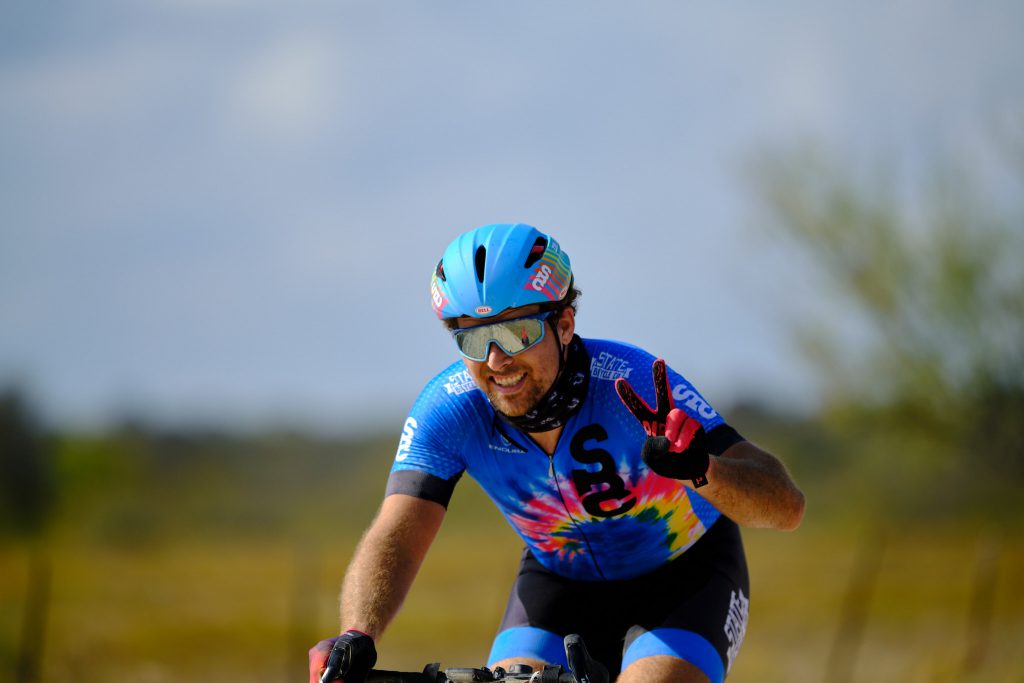
2021?
The great cancellation of 2020 put a huge damper on a year in which my goal was simply to “do bikes”. Now, with cooler weather and that niggling fall feeling of wanting to briefly put the bike down and look ahead, I’m left staring at a blank calendar speculating about 2021.
Certainly, there will be more events, right? The only two for which I’m confirmed are Unbound (Kanza) and The Garden State Fondo, with this year’s registrations deferred to next (add Castell Grind to that list as of a few days ago). Will the local crits and road races take place? Is the early-January gravel grinder still on? At this point, there’s no way to know, especially considering the haste with which many smaller races seem to be announced.
As much as I want to copy-paste my TrainingPeaks for a do-over of all that was missed in 2020, proceeding as though this all never happened, it simply isn’t possible. The idea of “eventually back to business as usual” that we all accepted as truth seems to be wearing thin. Some areas are reinstating new lockdowns and, from a personal standpoint, my employment situation could be pretty shaky by next summer.
Careening toward unemployment while participating in an expensive and possibly injurious sport feels irresponsible, especially with so many other interests, such as running, which I left behind for cycling.
At the same time, if events do return in full force, participation in each will be made all the sweeter by its prior loss in 2020.
It’s a Catch-22. Plan or don’t. Optimism or crushing reality…
Wait...
...no it isn’t. This is a false dichotomy caused by the internet and too much time alone. A depressive mope from looking backward rather than forward. A child who gives up after someone beat him to the first piece of candy that fell from the piñata.
Sure, things can seem pretty bleak when contemplating the dreariness of it all whilst doom scrolling through one’s newsfeed, but the thing I’ve noticed about bikes is that, after kitting up and dragging yourself outside, the weight of all that negativity falls away like…well, it just falls away. I think this is because bikes are a great way to launch oneself out of rumination and into reality. They’re a reminder that life is more your actions than thoughts, that doing something is more powerful than giving in to doing nothing, that things are gon’ be alright.
So, 2021…worth planning for? Absolutely. I just bought my Unbound bike, and if it doesn’t happen, so what? Things may not be perfect, it may be necessary to trade Rapha and carbon for cotton tees and steel, but that’s 1000x better than sitting home and waiting for perfection. Even if 2021’s calendar falls far short 2019, there will still be unofficial events, epic solo rides, unsanctioned races and group rides to enjoy. It's going to be fuarking awesome, because bikes.
Welcome to Austin, New Cyclist
Before COVID, Austin was an outstanding place to be. Wonderful bars and restaurants, great ways to experience nature, and a plethora of events every day of the week - all taking place in year-round nice weather (though sometimes a bit hot).
One more feather in Austin’s cap, and a big reason I continue to live here, is the city’s great cycling community. Austin is full of commuters, road cyclists, casual trail jaunt-ers anything in between (including some pretty awesome pedicab services). As with everything else, most cycling-related events have been cancelled this year, however, one thing that isn’t cancelled is enjoying the outdoors, which many have chosen to do by bike over the past several months. Nay, Covid has caused a bit of a national bike boom, with demand so high that many shops are repeatedly selling out of new stock, and maintenance services are backed up for weeks.
With so many new cyclists on the road, it’s a shame we can’t welcome them in the usual fashion. Someday, though, normalcy will return and, with it, all the things that make riding bikes in Austin great. You, new cyclist, should be ready when that day comes, so here’s an over of some of the more prominent contributors to the Austin cycling community.
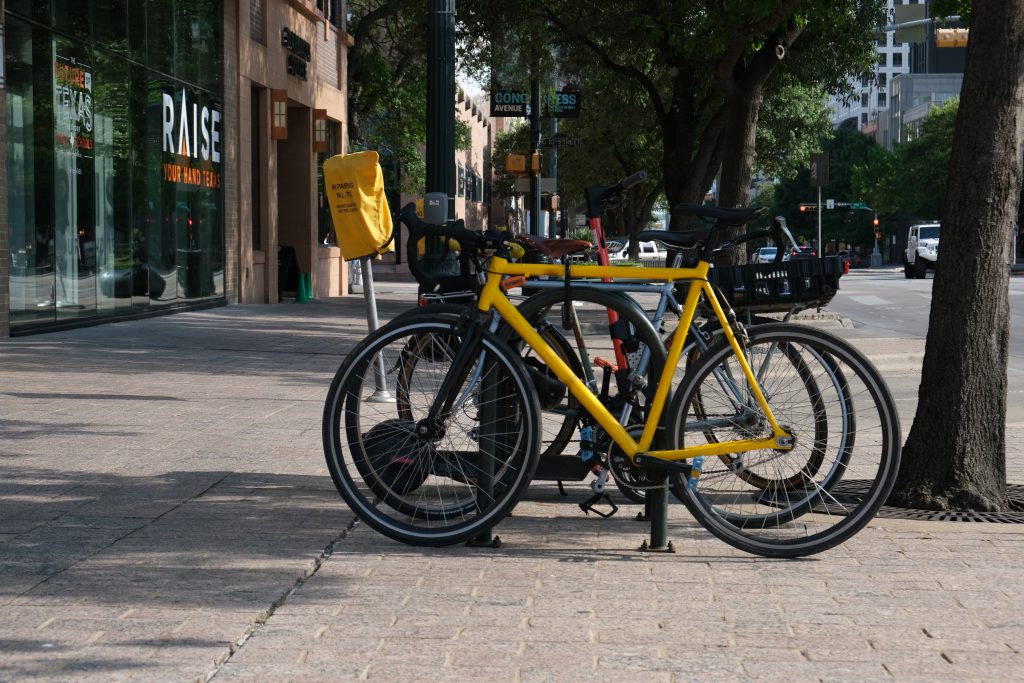
Organizations
Social Cycling Austin
Start here. Seriously. Social Cycling Austin is a FB group of over 12,000 members representing every possible cycling niche. The group is an amazing place to ask questions, find people to ride with, learn about Austin cycling, in general, and is also the home of the famous Thursday Night Social Ride, which has become an institution in the community. Think of SSA as your all-purpose, one-stop-shop for general cycling info in Austin.
https://www.facebook.com/groups/socialcyclingaustin
Bike Austin
It’s good to be a member of Bike Austin. This is an advocacy group that works closely with city government on bicycle issues - most importantly, safety. Bike Austin hosts rides, garners support for city projects and gives back to cyclists in the community. During COVID, the organization helped build support for Healthy Streets to allow pedestrians and cyclists to enjoy socially-distanced recreation without having to worry about automobile traffic. The more cyclists we can get behind Bike Austin the better.
Ghisallo Cycling Initiative
Ghisallo provides bike-related educational programs to Austin’s youth with the aim of creating lifelong cyclists, and also normalizing the use of bikes for transportation. The group conducts clinics focused on safe riding as well as numerous bicycle maintenance programs. If you’re a parent who wants to bring some cycling education to your child’s school, Ghisallo is a great place to start.
Violet Crown
Violet Crown is the oldest and largest cycling club in Austin, and they have the old newsletters and photos to prove it.If want to hear stories about Lance and the old Tuesday Nighter, Violet Crown is your jam. This organization facilitates numerous weekly group rides, and you’ll likely see riders sporting VC kit at other group rides as well. If you’re getting more serious about cycling and want to ride with faster groups or are considering racing, Violet Crown is a great place to get started.
Yellow Bike Project
Ya know all those micro-mobility scooters and bikes you see sitting all over the city? Well, Austin’s Yellow Bike Project was an early adopter in this area. In 1997, they repaired hundreds of bikes, painted them yellow and put them on the street for Austinites to use for their daily transportation needs, for free! Unfortunately, human nature got in the way and the project eventually fizzled out. Still, the organization remains and is an outstanding resource for purchasing reasonably priced bikes in Austin, as well as learning to repair your own bike. YBP is a community bike shop, offering classes, open community shops and even an earn-a-bike program, in which you can earn a free bike in exchange for volunteer hours. I highly recommend you visit the shop to see what it’s all about.
Coffee Outside ATX
#CoffeeOutside is a national community of cyclists who meet up for, well, coffee outside, and #CoffeeOutsideATX is Austin’s iteration of the group. Multiple different meeting places are used that showcase the city’s many outstanding parks. This is a small gathering, but a fun thing to do and good way to meet people if you’re new to Austin.
https://www.instagram.com/explore/tags/coffeeoutsideatx/
Bike Shops
Austin is chock full of bike shops. You’ll have no problem finding the one that fits your vibe. And though I hate to exclude any, as I’m thankful for all bike shops (even the bad ones), I’ll briefly include here those with which I have direct experience:
Mellow Johnny’s
Mentioned first because it’s the most famous shop in Austin. Mellow Johnny’s, so named because it sounds like the french maillot jaunt (yellow jersey), is owned by Lance Armstrong and is full of classic Tour de France bikes and other memorabilia. The cycling artifacts, in addition to it being a great shop, make photo-taking out-of-town visitors a common sight in the store. Is MJ’s a great shop for the casual cyclist? Sure, they’re friendly and have some nice hybrid/commuter bikes. Still, I perceive MJ’s to be more geared toward the serious racing cyclist. They carry a lot of high end stuff and prices can be shocking, especially if you’re simply interested in cruising the hike ’n bike trail.
https://austin.mellowjohnnys.com/
Cycleast
To me, Cycleast is the “hipster” shop. They have an amazing coffee shop on location and many of the bikes you see being sold or parked outside are of the steel (and sometimes single-speed) variety. But don’t be fooled, this shop hosts some amazing competitive riders and is also the home of Austin’s Phenom Cycle Club - a popular group in the racing community that holds the weekly Phenom 50 ride. I prefer to have my commuter serviced at Cycleast because they’re down-to-earth and reasonably priced (and within biking distance of my home).
Bicycle Sport Shop
I spend significantly more time at Mellow Johnny’s due to their co-located coffee shop, however, Bicycle Sport Shop is still my favorite shop in Austin, namely the South Lamar location. They’re huge and nationally known, with five locations in Austin, yet still manage to to feel welcoming and familiar. The owner, Hill Abel, is also an outspoken cycling advocate, which I appreciate. BSS caters to everyone, and is both an outstanding place to buy your first “real” bike, or your 10th high-end carbon race bike. Of all the shops in Austin, I’d say Bicycle Sport Shop appeals to the widest clientele.
Bike Farm
Let us not forget Bike Farm, a small shop slightly further away from my usual bubble of existence, but worth the trip nonetheless. Bike Farm carries brands that the other shops don’t, many of which are more reasonably priced. They also have a huge used a new-old-stock selection, which can be browsed online from the safety of your standing treadmill desk. Literature aficionados will also appreciate the titles on their service menu.
Other Events and Resources
CapMetro
Did you know that you can bring your bike on the bus? It’s true! Capital MetroRail also invites riders to bring their bikes. If you’re a commuter who lives a little further away and wants to use their bike for “last mile” purposes, CapMetro is a great way to do it. More transit centers are popping up around Austin and I can tell you from experience that it’s entirely possible to get around multi modally without driving.
https://www.capmetro.org/bikerack
Driveway Series
Even serious roadies who don't live in Austin know about The Driveway Series. It's arguably the best weekly criterium series in the country, and also a just a fun place to be. On Thursday evenings, you might see speed suit adorned riders making their way to the east side of town for the weekly race or returning at twilight for tacos and beer a La Mancha Tex Mex Tavern. Driveway is a culture and, in my opinion, one of the coolest thing about Austin. Here's an intense promo video from their site:
CotA Bike Night (is awesome)
Circuit of the Americas in an Austin landmark, and the only purpose built Formula One track in the United States. Its scale is hard to appreciate from afar, so why not see it up close? CotA Bike Night, held every Tuesday throughout the summer is fun way to ride without having to worry about traffic in a truly interesting environment. All kinds of riders are welcome. You’ll see teams doing workouts, families with kids, e-bikes and everything in between. Worried about climbing the 11% grade before turn 1? No problem. There’s a bypass to skip that portion of the track, but I recommend you take on the challenge at least once. Check out the view:
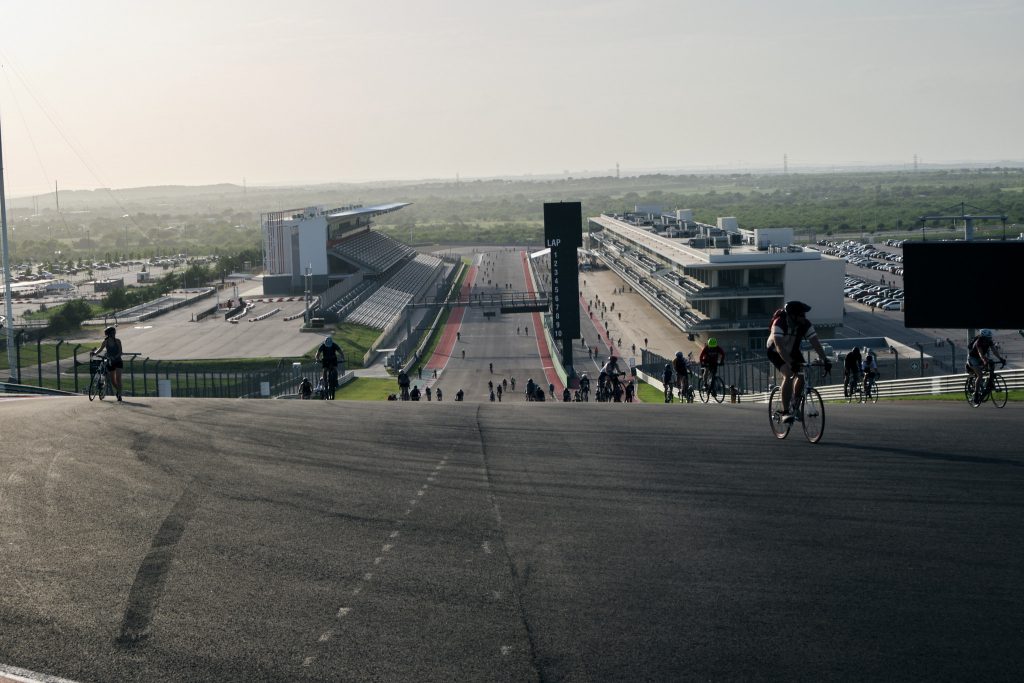
http://circuitoftheamericas.com/bike
The Veloway
The Veloway at Circle C Ranch Metropolitan Park was constructed in the early 90’s and was the first facility of its kind in the United States. The Veloway is a 23’ wide, 3.1 miles (5K) long bicycle tract that traverses the natural terrain. People travel from all over the metropolitan region to cycle here on a daily basis. The project was partially funded by a Texas Parks and Wildlife Grant. (I copy-pasted this)
https://austintexas.gov/department/veloway
Austin Bicycle Map
You’ll likely see this near the checkout in local shops, but it’s also available online.
Here’s the PDF - https://austintexas.gov/sites/default/files/files/COA_bike_map_v12_FULL_web.pdf.
And an interactive version - https://www.arcgis.com/apps/webappviewer/index.html?id=5d0284294f1b41bcad4ea956274a83b3&extent=3084002.7769,10048871.3815,3148002.7769,10081338.0481,102739
The map is well done, and I’ll say that I concur with most of the routes and comfort levels described.
Is Austin a bicycling Mecca? No. Riding here has its problems. There’s the ever-growing sprawl, crazy driving and a striking carelessness about transportation safety. Still, the city has a critical mass of riders that has normalized the sight of cyclists on the road and, as traffic gets worse, many of those who are able are choosing to get around by bike. The site of e-bikes during the morning and evening rush is getting quite common.
What makes riding in Austin great are the people. Take advantage of or get involved in the resources I’ve mentioned here and you’ll quickly find your niche.
Driveway Returns
Bike racing is back! In Austin, at least. After two practice sessions in which organizers worked out their socially distanced staging and start procedures, and riders got a chance to remember what it feels like to ride in a group, the Driveway Series held its first race since COVID19 shut things down in March. The lack of beers, burritos and socializing during the event is a bit of a downer, but a weekly group cycling activity is, nonetheless, far superior to having nothing at all.
The postponement of Driveway was the loss of the nucleus of road cycling in Austin. We have an unusually strong race-oriented cycling community for a city of this size, with amazing group rides and a plethora of outstanding bike shops, all of which serve to support the weekly running of one of the best criterium series in the nation. We’re fortunate to have Driveway at a time when road racing is seeing an overall decline in participation, and I think it provides a strong motivation to train for a large portion of the Austin road-cycling community.
Personally, the loss of the Driveway and group rides significantly reduced my motivation to train. Sure, there’s always Strava, but something about being dropped or struggling for breath while the person next to you continues their casual conversation seems to more thoroughly shame me into not skipping workouts.
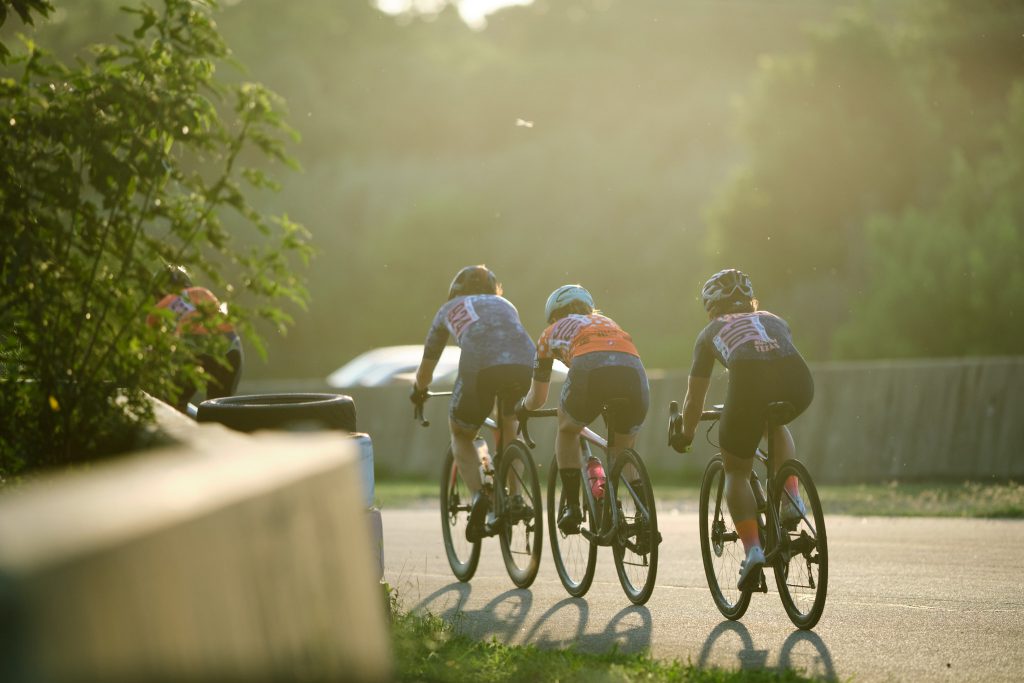
I was present for one of the practice sessions as well as the first two races. It was so good to feel the community vibe we’ve been missing for over three months. A poorly timed meal led me to dropping out (excuses) of the first event and I was dropped this week, but I didn’t regret participating. Afterward, though, I couldn’t help but ruminate on the nagging question that’s probably on everyone’s mind: Should we be doing this?
Some googling reveals hints of upcoming USA Cycling sanctioned events, but Driveway Series seems to be one of the first to reopen. USA Cycling began accepting event permits starting on June 1st, however, organizers are still beholden to local regulations, which are limiting what’s possible in many states. Here in Texas, “adult sporting leagues” have permission to operate and, as long as it’s legal, that’s exactly what Driveway is doing.
Risk?
A scary image has made its rounds on the internet over the past few months that succinctly describes what we’re all picturing when it comes to riding in groups. Are we doing this to each other?:
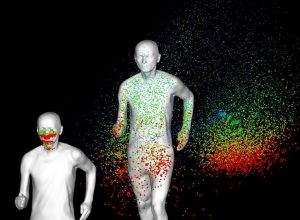
The image is from a study conducted in Belgium that spread quickly through social media, probably because it’s alarming, and what better purpose does Facebook serve than to spread hysteria? The purpose of the study was to examine the possibility of COVID-19 contagion through exhaled aerosols. And though the study wasn’t as comprehensive as many were led to believe, it’s certainly worth considering in light of uncertainties about how the virus spreads.
Numerous other studies look into spread via exhaled droplets and aerosols, but none come close to simulating a peloton of heavy-breathing cyclists moving at 25+ mph in 95 degree heat and 70% humidity. How fast is the air around me dispersed? How quickly is my breath evaporating?
According to USA Cycling’s Chief Medical Officer, Dr. Michael Roshon, the risk of outdoor spread of the virus is quite low. This even holds true for well-ventilated enclosed spaces, such as on airplanes.
Should we listen to Dr. Roshon? I don’t know, but the fact that the race is taking place shouldn’t remove all suspicion about whether participation is safe.
The CDC, WHO and City of Austin’s guidance surrounding the virus is certainly worth heeding if we’re to assume that the virus is present in the peloton. But what if it isn’t? Should an estimate of the likelihood that we’re coming into contact with infected individuals be part of our personal assessment of whether it’s safe to race? I’m sure this is a calculation everyone made before the event. And what about age? From a personal risk standpoint, most participants are in low-risk age groups. Still, helping to slow the spread for the greater good should be the goal for low-risk populations.
Race organizers take temperatures at the gate, don’t allow spectators, require socially distanced staging and require participants to leave immediately after the race. The only real opportunity to spread the virus is while riding within the size-limited field. If someone in the group is infected, how much are the others being exposed? Is it enough to catch COVID19?
So little is understood about how the virus spreads and, in this particular setting, even less so. If we’re to follow the ethos of taking every possible precaution against the virus, then no, racing probably isn’t recommended. But when one considers the socioeconomic position of the participants — mostly professional class knowledge workers who are able to work from home or young people who aren’t currently in school — as well as the groups and overall numbers affected by COVID19 in Austin, viewable on the dashboard, I have to wonder how likely it is that another rider is a carrier. Though I’m wearing a mask as I write this, my inconsiderate, self-justifying estimation tells me that participation is generally safe due to the low chance of encountering an affected rider, along with the (perceived) small probability of spread during a crit race.
In looking ahead at upcoming events on BikeReg, it’s unclear what’s actually taking place and what simply hasn’t been updated. My out-of-town ‘A’ event for September was just canceled, and the TXBRA calendar looks bleak, with everything but a couple of gravel events and Driveway marked as ‘Suspended’. As a goal-oriented person without much to do, I’m personally willing to take the risk and race my bike. It’s something to look forward to while everything else in life is put on hold, and the risk to myself and others is small, especially when compared to all the other risks one might encounter by spending ten hours per week on a bicycle.
I support the decision to reopen the Driveway Series. It’s a shining star with big potential on a shrinking road racing schedule. If a tiny risk must be borne for Driveway to survive, then so be it.
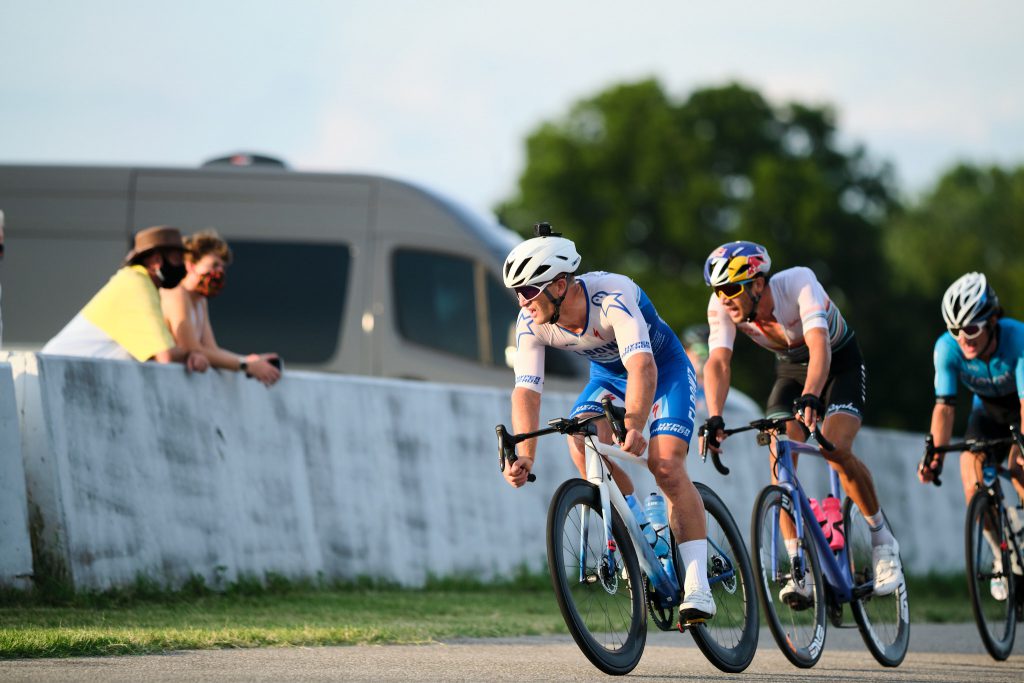
Legalize the Idaho Stop Law in Austin
Despite the growth of unchecked sprawl at its periphery as well as the city’s total disregard for safe streets, getting around certain parts of Austin by bike is entirely possible, especially within a four mile radius of downtown. Unfortunately, due to the city’s housing policies, our most bike friendly areas are increasingly becoming the realm of the wealthy (but that’s a discussion for another day). The fact of the matter is that you can easily get around Austin by bike.
Aside from hills and heat, both easily mitigated by fitness, electricity and the simple acceptance that humans sweat, route selection is among the biggest obstacles to riding in the city. And while much of your travel can be conducted on secondary roads, our main thoroughfares still often present the best route from A to B. Roads such as S Lamar, S Congress, 51st, Guadalupe and Ceasar Chavez all regularly see cyclists while also accommodating high volumes of cars occupied by drivers texting, speeding and taking an after-work toke on the drive home (a common smell from vehicles if you regularly ride/walk/run).
How can we vulnerable road users protect ourselves from thousands of mild-mannered office workers who suddenly become murderous, street clogging lawbreakers on their drive home?
One way is the ride defensively: Always assume cars are going to pull in front you, look over your shoulder at approaching cars, make eye contact, take the lane to discourage unsafe passing — there are many techniques. One, however, though legal in the state of its namesake, is quite controversial: The Idaho Stop.
To explain it simply, the Idaho Stop essentially allows cyclists to treat stop signs as yield signs and red lights as stop signs – something many of us already do. The full law can be read here: https://legislature.idaho.gov/statutesrules/idstat/title49/t49ch7/sect49-720/.
What makes the Idaho Stop a defensive technique?
Let’s say we’re heading north on S Lamar on our way to work, and are stopped by the light at Oltorf along with a multitude of giant, singly-occupied metal boxes (adorned with bull bars, of course). Work is just ahead on the left, but transitioning across the lanes among all those sleepy drivers is scary. Oltorf looks clear. What if we just jump ahead of the light while the lanes are empty to safely position ourselves for the left turn, instead of trying to direct a bunch of drivers to “get the eff out of the way and stop trying to kill me as I turn left!”
Or maybe we’re heading home, dutifully ascending S Congress in the bike lane (except when blocked by giant waste-of-space trucks). The light turns red at Gibson. All that momentum, gone! But why sit here? There’s much more climbing to go and Gibson is always empty anyway. Perhaps we’ll just continue our climb with the added benefit of entering the field of view of the many drivers waiting at the light. This lane is, after all, somewhat narrow and unprotected. It’s a justified precaution.
What about stop signs? Well, have you ever traveled S 5th heading toward the city? It’s like two-mile funnel, sending millennials and hippies on commuter bikes into downtown in seven minutes flat. But all those stop signs? Does anybody actually stop? No, they slow down and look both ways, and then continue. Avoiding the loss of momentum and increasing the viability of their chosen mode of transportation. Is this particular example defensive? Not really, but it certainly makes cycling for transportation easier in our ultra spread out city. Consider it “defending your right to ride”.
If you’ve ever driven on Oltorf or S 1st, you know that drivers travel at incredible speeds, hurtling their multi-thousand pound autos through largely residential and pedestrian-trafficked areas. It’s dangerous. I like to think of running stop signs on S 5th as the much safer and saner, yet logically equivalent version of this same act.
What’s more, bikes don’t automatically trigger the lights on cross streets in many areas. Live Oak and S 1st is an example. An individual on a bike should have to push the button just as often as an individual in a car, which is to say “never” (though I’m open to watching drivers have to get out and push the button).
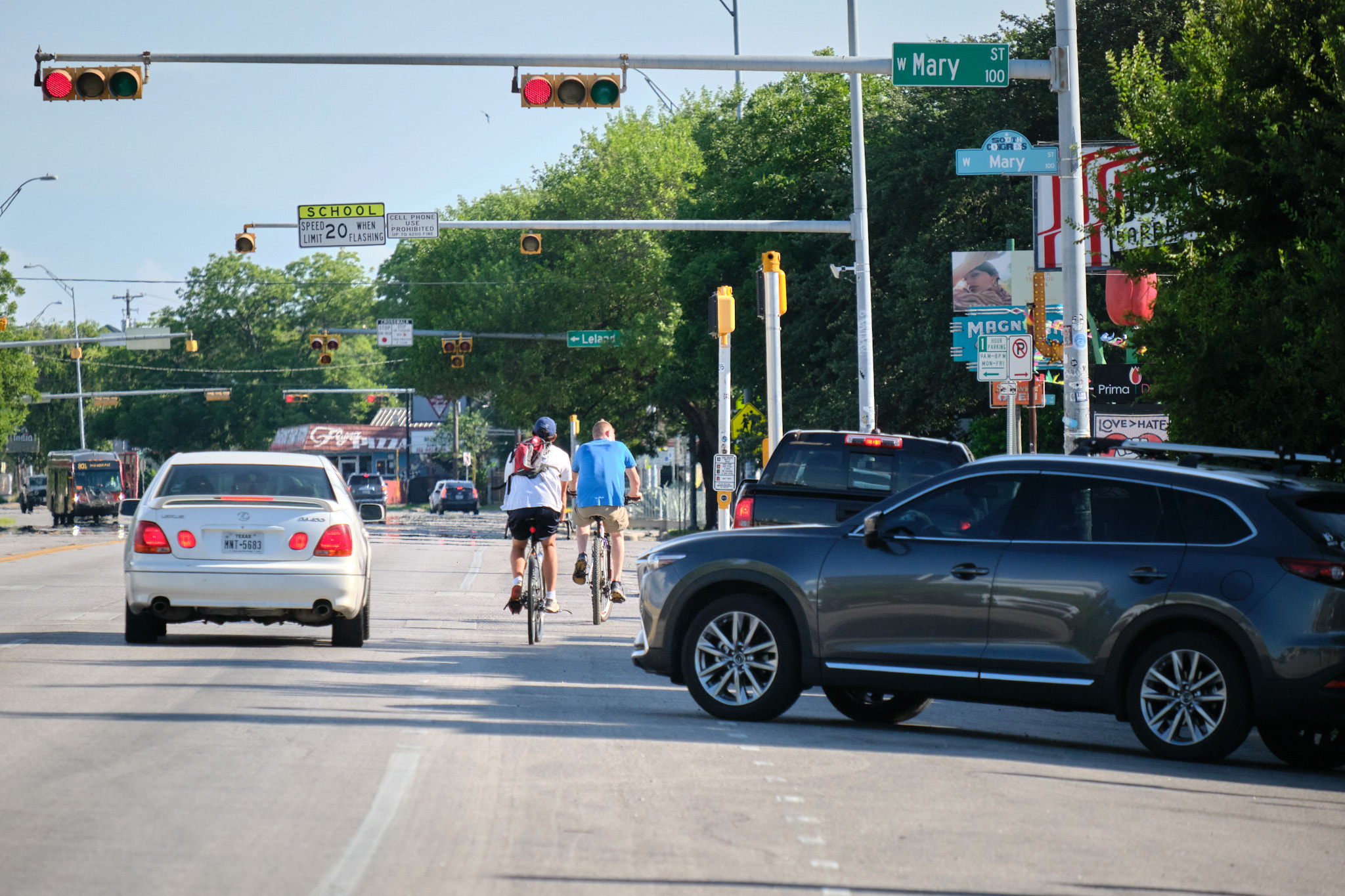
It Isn’t Fair
There’s something about the sight of cyclists eschewing traffic laws that causes ire. I take this as a complement, as it means we cyclists present as human. Note how often automobiles are given agency: “That car got in my way”, “Why is that truck driving so fast?”. Not so with bikes. Imagine referring to another cyclists as a “bike”.
And so it is that, with the cyclist’s humanness on full display, drivers are upset by the sight of seeing a law broken which they themselves are so dutifully following, all while the chaos of traffic swirls around them. “It isn’t fair,” they think, and maybe they’re right.
But is a de facto requirement for car ownership in most parts of the city fair? Is having the entire world paved over for giant, multi-thousand pound wheelchairs at incalculable cost to the livability of our city fair? Is it fair that we build two/three/four lane roads near the edge of town at the drop of a hat for potential newcomers, while safe bike lanes are almost nonexistent and met with forceful resistance?
My arguments are fallacious, of course. The law is the law and fairness has nothing to do with it. Still, a minor act of civil disobedience in exchange for personal safety seems like a good trade. Running a stop sign or crossing against a red light isn’t usually a flippant flouting of the law, but a rational acknowledgment of the unmet needs of cyclists attempting to move through an environment designed for automobiles. Surely, running a red light for safety and efficiency is more noble than driving 20mph over the speed limit on E Riverside while texting, right?
Legalize It
In FY2019, APD wrote 103 traffic tickets for cyclists running red lights and stop signs, down from 158 in 2016. Surely, some of these were the result of unsafe riding, however, darting from the sidewalk into the road or bombing through a red light isn’t the same thing as a vehicular cyclist yielding and then continuing at a stop sign or, after waiting, riding against the red through a clear intersection.
Though the heat can sometimes be intense, Austin weather is a dream for getting around by bike. In choosing to ride, a cyclist is doing the city a service by getting one less car off Austin’s overflowing streets and helping to decrease demand for expensive and inefficient automobile infrastructure, including the massive amount of parking that takes up so much of our city.
Let’s return the favor. Rather than punishing cyclists for doing what we know they’re going to do and upholding the cyclist-as-lawbreaker ethos, the city should declare its support for a mode of transportation with no downsides, and become a role model for forward thinking urban transportation policy in the United States.
Riding Under COVID-19
“Alone but together” - I feel like I’ve seen this phrase multiple times now on Strava activities and cycling-related Instagram posts, and it’s often come to mind as familiar faces glide past me along popular road cycling routes in the city. Where my gestures of ‘hello’ were once unenthusiastic (and probably invisible when offered from mid-pack in a large group) I now send a more sincere wave, an expression of solidarity, from one individual to another as we pass on our pandemic-induced, solitary journeys - alone, but together.
My road riding pursuits over the past few years have been mostly event and group ride oriented. Rather than simply a form of exercise, as I once saw running, participation in races and community events are my primary motivation for cycling. Now, with no events to speak of, I feel like my desire to ride has been pulled from under me. No social interaction to look forward to, no upcoming races to motivate my training, and no cycling-related coffee shop or bar events at which I can feel like part of the “scene” (while standing alone with my drink).
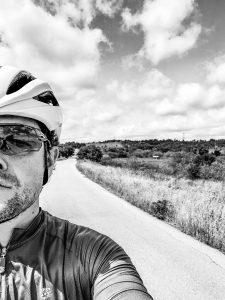
Community is such a big part of cycling, no matter your preferred discipline. With difficult and time consuming training, expensive equipment, slow progress and tough events, riding can feel like a beat down, and we Freds sometimes need others to pick us up. I can’t tell you the number of times, upon seeing some local hero’s Strava activity, that I’ve been motivated to go out myself. Or how often a poor event result has pushed me to stick to a training plan.
In the loss of this community to stay-at-home orders and social distancing, I find my interests drifting toward some of the more individual riding pursuits that first piqued my interest in bikes: aimless rambles on my commuter, exploratory gravel rides, touring, the novelty in fixed-gear/single speed riding. Going hard for hours on a carbon bike in expensive kit seems to make less sense when there isn’t any place to showcase that fitness (except Strava). This kind of riding is starting to feel out of touch, like the wrong tool for the job of keeping this amazing hobby fulfilling. And with the threat of a layoff looming, the expense of race oriented training and equipment feels even more silly. Will I be able to afford registration fees and travel? Will there be time to go on 5+ hour rides if I’m struggling to make ends meet? Will long work hours sap my energy? The Rapha-esque signaling that one sees so often in this sport feels frivolous and empty in the face of hardship, while hauling groceries or cruising the trail on my old commuter somehow feels “right”. Maybe that’s because it’s where I started — a sort of regression as life starts to break down.
Normalcy is still a long way off and, while I’ll certainly keep riding, the "what-ifs" generated by the adversity of the past few months will forever change the way I look at cycling. Where once I may have thought of a workout in terms of gaining fitness or staying slim, my mind is now more focused training as goal achievement. Group rides will no longer be about winning or hanging out with the cool kids, but community and advocacy. My bikes are now more tool than social signal, ridden with gratitude, rather than thoughts about obtaining something newer and lighter.
Seeing things in this way isn’t new to me (I'm not that shallow!), though it’s definitely easier when circumstances focus your attention on how quickly it can all be lost. I’m so fortunate to have the time, money and perseverance to be a cyclist, and that fact is now clearer than ever.
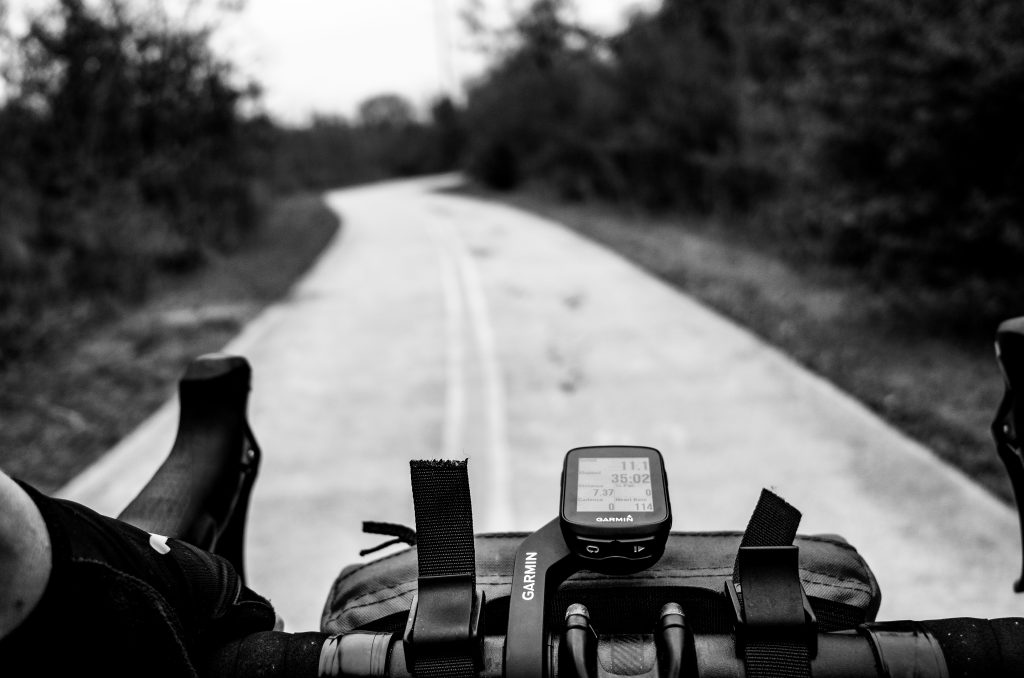
A Commuter
Growing up in the suburbs of a small midwestern town, with low-traffic streets and trails connecting me to friends, my bicycle was freedom. At a moment’s notice, we could pedal to the next house, a nearby pond, a trail into the woods, even to school - a journey we sometimes undertook in the days when parental sensibilities still allowed young children to explore.
From among my earliest memories, I recall noticing the sensation of balance when my training wheels, installed slightly high, would leave the ground and, for a few seconds, stay that way as I rode as straight as possible. The day I had them removed, I took my bike into the driveway, aligned myself with the longest stretch available and, after only a few attempts, became a cyclist.
As is the case with so many American children, I grew out of cycling as I got older. There was an interest in mountain biking in my early teens, and I had a bike in college until it was stolen (sold by an acquaintance to buy weed, I suspect). After that, I didn’t ride for years. It wasn’t until my 30s, upon moving to a city with horrible traffic, but also the type of weather that allows year-round cycling and a modicum of bike infrastructure, that I began to ride again.
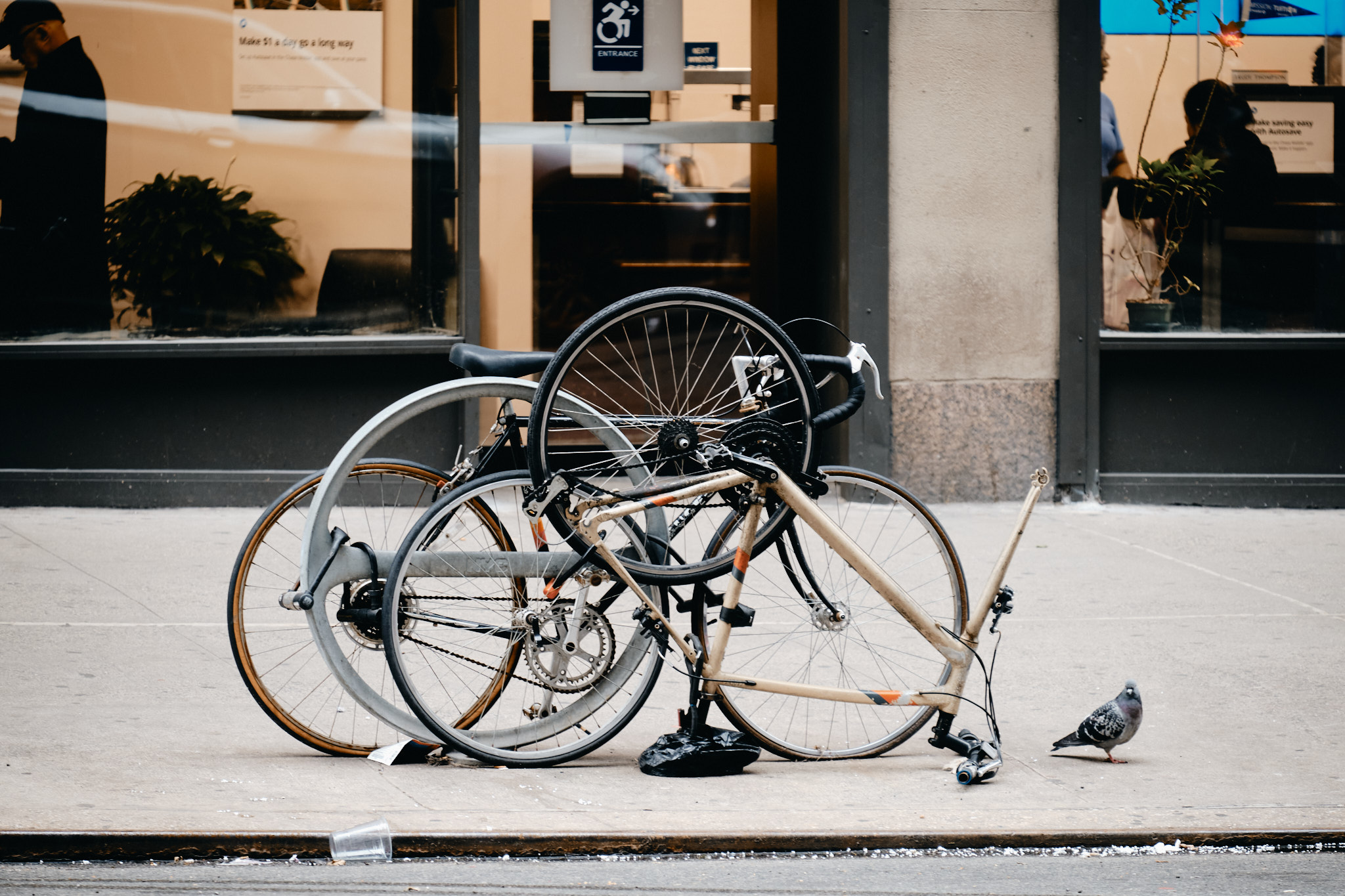
At first, it felt quite forced. The effort of going outside and exposing oneself to the slightly uncomfortable elements, of having to dress properly, expend effort, and take extra time to reach my destination, often led me to hop in the car. Yet, with a higher than average proportion of transportation cyclists in my city, this choice frequently left me feeling remorseful, as I’d inevitably see one braver and more determined than me out on their bike. I have a rule that I usually simply call the “You’ll Be Glad You Did Rule,” which says that if you’ll just do the more rewarding (and usually more challenging) thing, rather than giving in to your inertia, that “you’ll be glad you did”. This rule holds true every time I hop on my bike and, over time, car trips to the grocery store, coffee shop, barber, etc. dwindled to the point of my selling the car - a beater of a Honda Accord that, frankly, I was a little embarrassed to drive anyway.
Something about selling that car led me to feel that I had “officially” become a transportation cyclist, even if most of my trips were previously conducted in this manner. Sure, I still take Ubers, public transit, or occasionally ride the ever controversial e-scooter, but this multi-modal approach is centered around my bike. I never knew getting from A to B could be so gratifying and positive until I started traveling in this manner, however, every ride, no matter the setting, is overshadowed by the dark cloud of American infrastructure and our cultural ideas about transportation.
Formerly, as a frequent runner, I was often disgusted by how hostile our city environments are to humans. Everything we build is car-sized, and running through wastelands of traffic, gas stations and chain restaurants to find the “nice” parts of town was an education in how poorly designed our cities are for anyone but drivers. We’ve laid out the red carpet for multi-thousand dollar hunks of private property to glide through cities with ease without much thought given to the movement of humans.
While running along from the relative safety of the sidewalk, I never felt terribly threatened by the traffic shooting past me (though the noise can be stressful). Considering the number of pedestrians killed annually in the United States, perhaps this feeling was naive. Still, on foot, I felt that I could dart from the path of a straying vehicle and mostly exist outside of the world of motorists.
The experience is completely different on a bicycle. One is required to leave the sidewalk, crossing that white line to join the realm of the automobile. Here, the standards of civilized behavior no longer apply and something like the reptilian id seems to take over. At its most extreme, incidents of road rage lead drivers to intentionally threaten and injure, while our daily experience is filled with events such as honking (the eardrums of all those outside of the climate-controlled cage be damned), close-calls and speeding. Here on the road, whether protected by 3000 pounds of metal or 10oz of t-shirt, we’re no longer humans. Maybe it’s the tinted windows or the fact that we can’t look each other in the eye and say to ourselves, “That’s another person,” or perhaps its movement at speeds greater than our minds have evolved to comprehend. This reality is reflected in our speech and writing, where the vehicle is given agency over its driver: “Pedestrian killed after being struck by SUV”, “That car needs to get out of my way.” Even design standards for American vehicles reflect this. Imagine Ford or GM taking care to protect pedestrians by building lower grills on their fast-selling trucks, or drivers thinking twice about whether installing that brush guard and metal bumper will reduce the safety of other drivers.
It’s in this world that I, the cyclist, exist. Despite my clear vulnerability (and being being visibly human), I’m lumped into this non-human river of metal. Cruising home from the library or my favorite coffee shop, using trails when possible and roads when necessary, I become an obstacle rather than a person. Drivers may dangerously pass rather than wait the extra ten seconds necessary to reach a safe opening, despite the fact that we’re both racing for a red light in which I’ll quickly catch up. Actually, our average speeds are often closely matched during rush hour. If fortunate enough to have a bike lane on my journey, I’ll be gifted with glimpses of passing drivers on their phones, playing roulette with my life as they check their texts or type addresses into Google Maps.
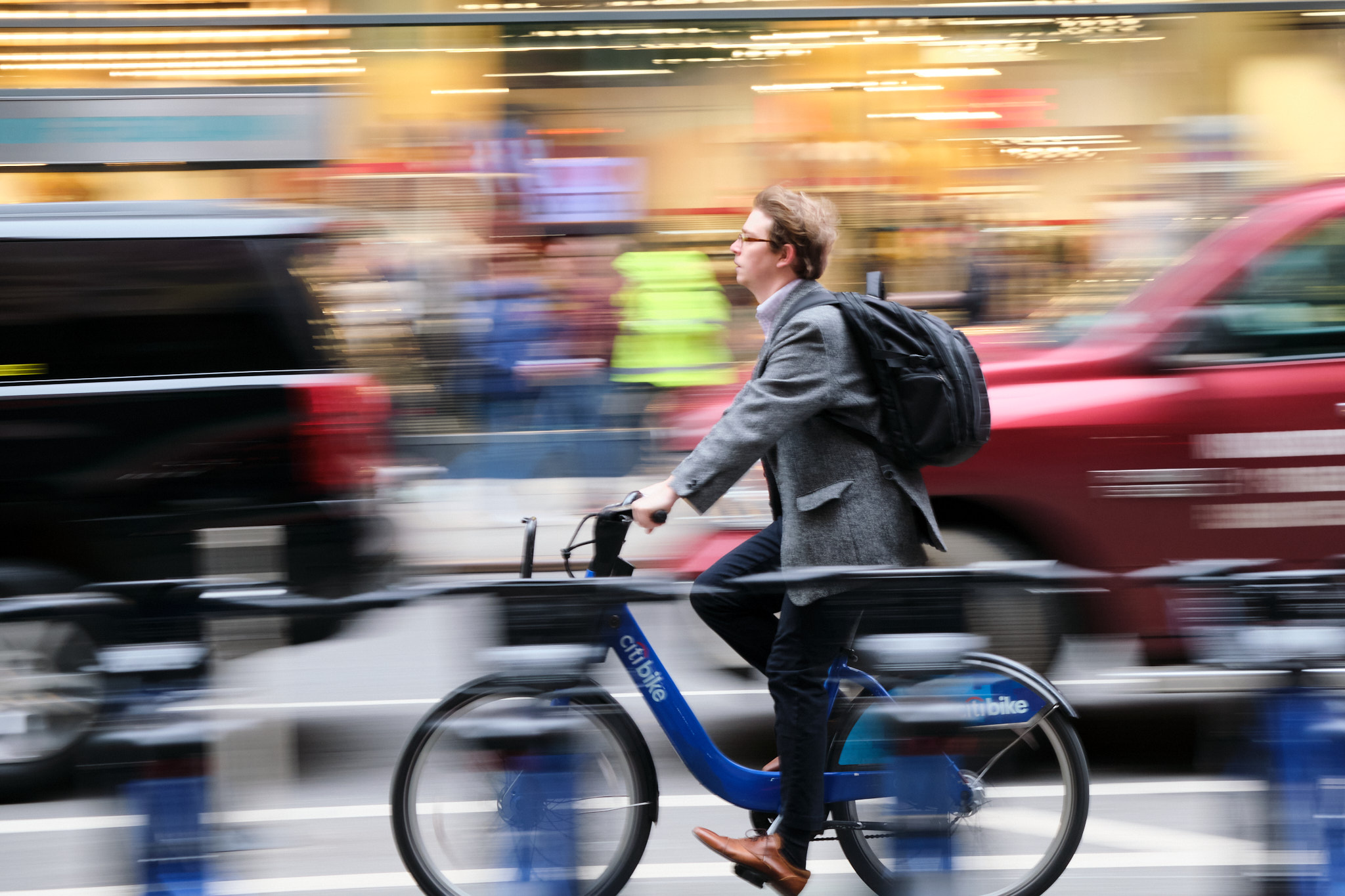
Arriving at a destination with that tinge of righteous anger at the unfairness of it all, the kind that you sometimes see come out in cyclists as they maliciously block the lane or swipe a vehicle’s mirror, I have to calm myself and realize that it isn’t the drivers’ fault. As a cyclist, I represent a tiny minority in a country where driving has been normalized and subsidized to a degree that most lack the ability to even comprehend an alternative reality. While riding, the sight of a police officer enforcing simple traffic laws, or sensible road engineering for intra-city travel, or well-implemented traffic-calming measures are so rare as to be practically nonexistent. All of this is exacerbated by sprawling development patterns, stacking more tax-revenue-sucking roads further and further from the city center until only the most determined and brave among us can even attempt to ride.
Cycling advocacy organizations of the type that support transportation cyclists are usually met with strong resistance when asking for safer infrastructure. The idea that one would want the freedom to travel outside of their expensive wheelchair is seen as absurd by the ruling generation, two-thirds of whom are overweight or obese. And despite the fiscal responsibility and “small government” ethos of legalizing density and self-sustaining infrastructure, my cycling is treated as a “Liberal” pursuit by conservative media, essentially settling the matter for half the country.
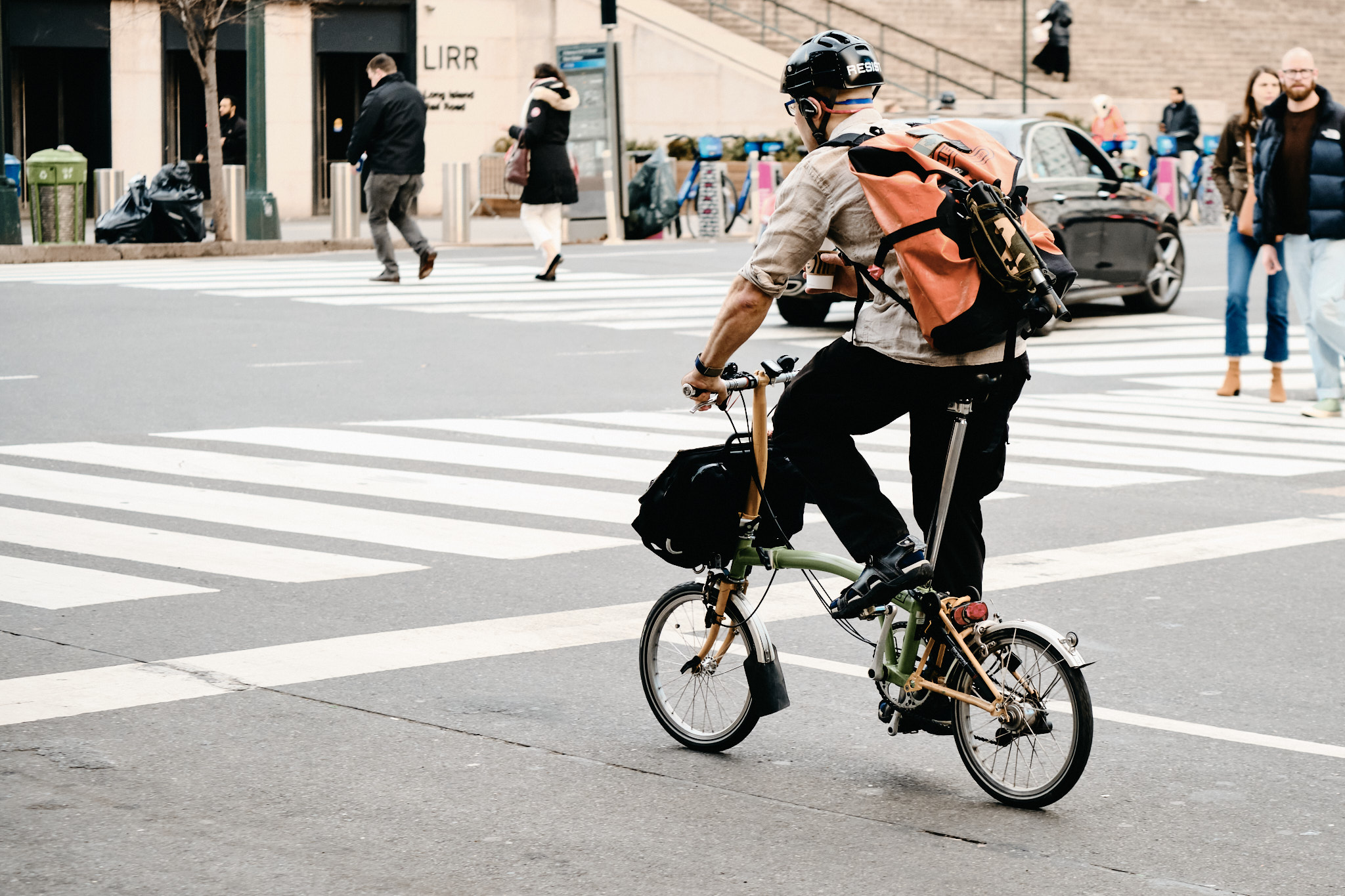
Where we do have bicycle infrastructure, it’s designed to serve the rich. In cities, the wealthy and educated ride for transportation just as often as the very poor - one group by choice and the other by necessity. Unfortunately, the poor will be riding in high traffic areas with no bicycle infrastructure and fast speed limits, often without training or an understanding of their claim on the public right-of-way. If these riders were to attempt to travel from city-center to home, their route would eventually empty into a concrete plain of high-speed, wide roads with intermittent sidewalks or the empty promise of a shoulder-painted bike lane along a 45+ mph street, more a product of failed policy than true infrastructure.
Despite the fact that cycling in America is a front row seat to how terribly we’ve failed at building cities, at how much we’ve bent to the will of the auto-lobby and ignored the basic needs of Americans, I can’t help but keep it up. At quiet hours or on low-traffic routes, passing through the city and its parks is often more a joy that enhances even the most mundane errands. Smelling the morning air and just being in the environment on a sunny morning, regardless of traffic, is one of the best parts of my day. On rainy afternoons, the empty streets are a secret world through which I can silently glide, the rain on my face instantly breaking the monotony of everyday life. “The journey is the destination” rings truer than ever on a bicycle, and on completing the errand, one is rewarded with a sense of satisfaction for having worked for something, for having the grit to walk out the door, briefly shedding modern comforts to do something for oneself (and for everyone else too).
The best part, though, is the humanness of it all. Bicycles lie opposite the isolation of automobile travel. Not only do you see the drivers, to whom you don’t exist, but also passing pedestrians, and runners in the park, and visitors to the dog run, and every other person you cross along the way, and they see you to too, another human going about their day. Cycling incites a sense of community that’s been lost to our soulless sprawl, big box store parking lots and long auto commutes. It’s addicting, and so what can I do but keep riding? To set an example, advocate for change, and hope that someday we remember that cities are for people.
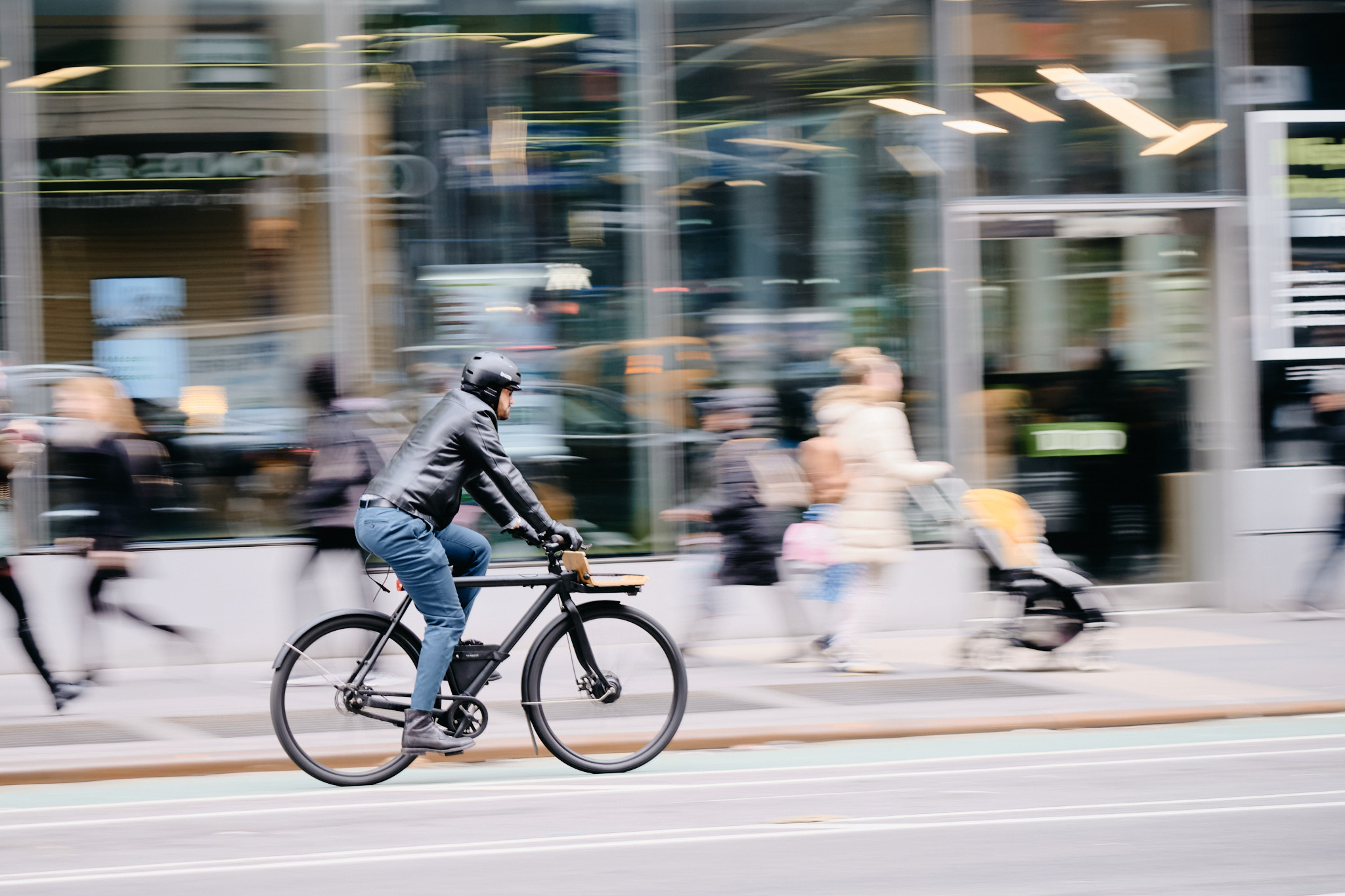
Bike for Your Country
Yes, for your country. While patriotic flags and sayings may often adorn large SUVs driven by soccer moms and suburban cowboys, it doesn’t take much effort to slap a flag sticker on your truck. Those who truly want to display their patriotism through mobility choose a mode of transportation quite the opposite from a world-burning Dodgy Ram.
The fact of the matter is that, flag-bearing or not, these vehicles take up an immense amount of space, not only in their immediate footprint or while idly parked (where they live 95% of the time), but also in the required road network, parking and general auto-centric development pattern needed for their utilization - a system that comes at a huge price to American citizens, both in direct costs and, also, indirectly in the form of lost productivity, excessive land use, inefficiency and the displacement of those who can’t afford to live close to where they work.
After 70 years of developing our cities for automobiles rather than humans, the average citizen has become somewhat “car blind”. Still, the case remains that alternatives exist. These alternatives are more efficient, cheaper, more “free market”, and better for the environment, yet the automobile remains “the answer” to most citizens, who know nothing else and, understandably, hardly have time to think about much more than making ends meet, let alone reading about transportation issues in their free time.
“Free market? Forcing bike lanes and trains down my throat isn’t free market,” you might say. This is understandable. Years of market-distorting laws favoring automobile transportation are what got us here, such as parking minimums, single-family residential zoning, square footage minimums, development requirements for wide, high speed roads - the list goes on. What’s resulted is a cycle of auto dependency where alternatives to automobile transportation have become impossible, with endless federal funds in the form of what amounts to payday loans to keep the auto-centric development churning. With unchecked state and federal road infrastructure funding , there’s no incentive to stop building cities outward into expensive non-places full of big box stores and cookie cutter snout-house subdivisions - places inhospitable humans not encased safely SUVs.
That’s where bikes come in. Your town, city, municipality, or village may not have acceptable transit service, everything is too spread out to walk, Uber-ing everywhere is prohibitively expensive, and autonomous vehicles are still a Silicon Valley fantasy. The bicycle, however, in all its high-efficiency glory, can move a human just far enough, just fast enough, to get them where they’re going without having to drive. No, if you live in the country and have to take Farm to Market 920 (i.e., Sprawl to Parking 920) fifteen miles to the grocery store, bicycling probably won’t work for you. If, however, you’re anyone from a small town dweller, up to and including a city slicker who has amenities within a reasonable distance of home - you can absolutely ride your bike for transportation.
Below is a picture of my “car”. Within a reasonable radius of my apartment, I run any errand I please without a second thought. Too hot? Humans sweat. Too cold? I’ll warm up with a little movement. Rain? Where I live, it doesn’t rain continuously, but I save enough not owning a car to justify buying some pretty awesome rain gear (or to be chauffeured to my destination in an Uber on special occasions).
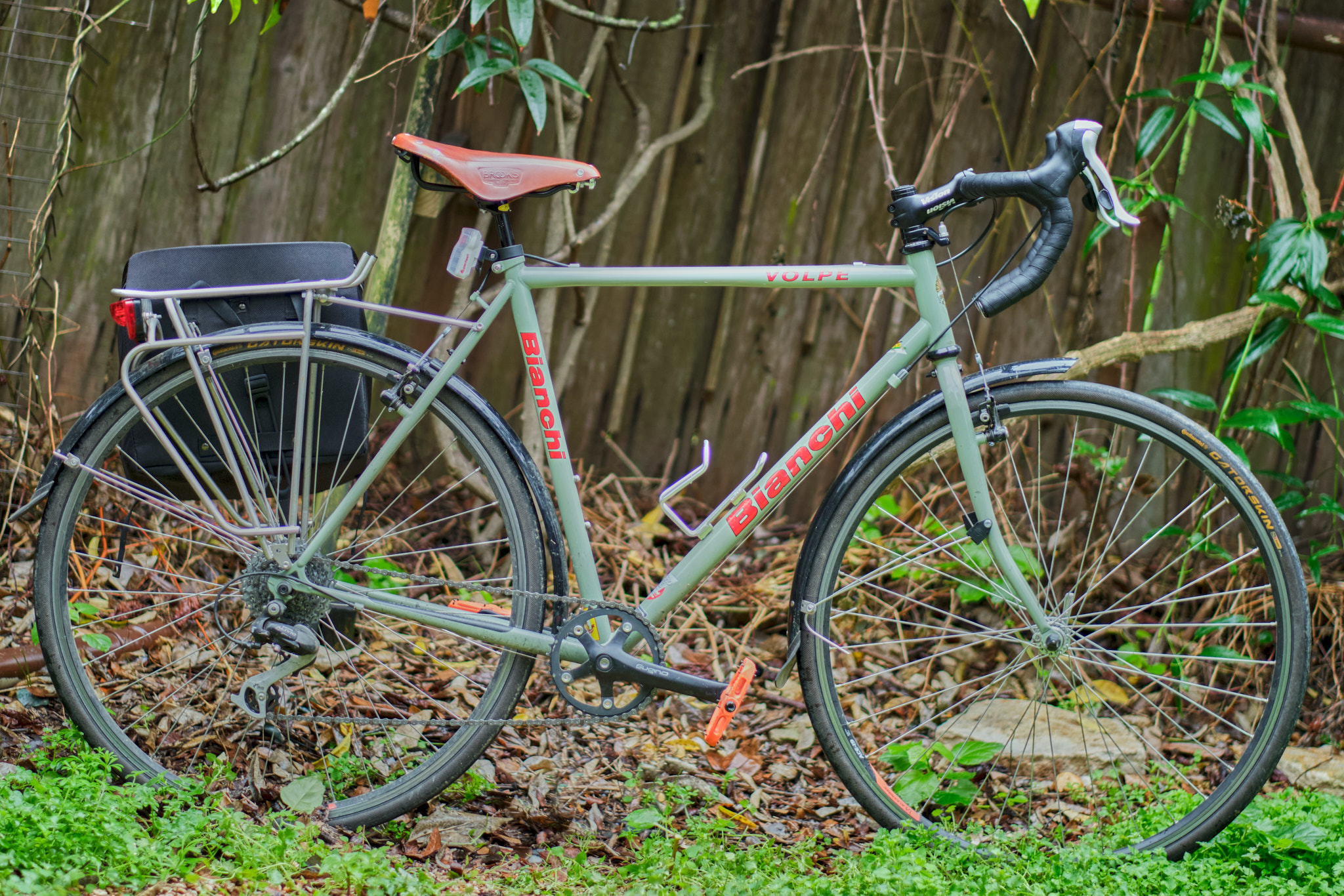
My area isn’t dense. Houses have yards, there are ugly parking lots and soulless big box stores, nonetheless, everything I need is close enough to reach by bike and I’m fortunate enough to have relatively safe streets on which to make these trips.
The most striking thing about my trips is how much I’m slowed down by automobile infrastructure. In most cases, I can reach my destination in less time than it takes to drive (especially during rush hour) utilizing sidewalks, trails and the “Idaho Stop” (civil disobedience, right?). Single-family housing, parking and excessive, land-wasting roads take up most of the space between points A and B. I, and every cyclists I see along the way, however, require very little space. This image does a good job of illustrating that:
Every additional cyclist on the road highlights the absurdity of the development patterns we have in place. Designing for this:
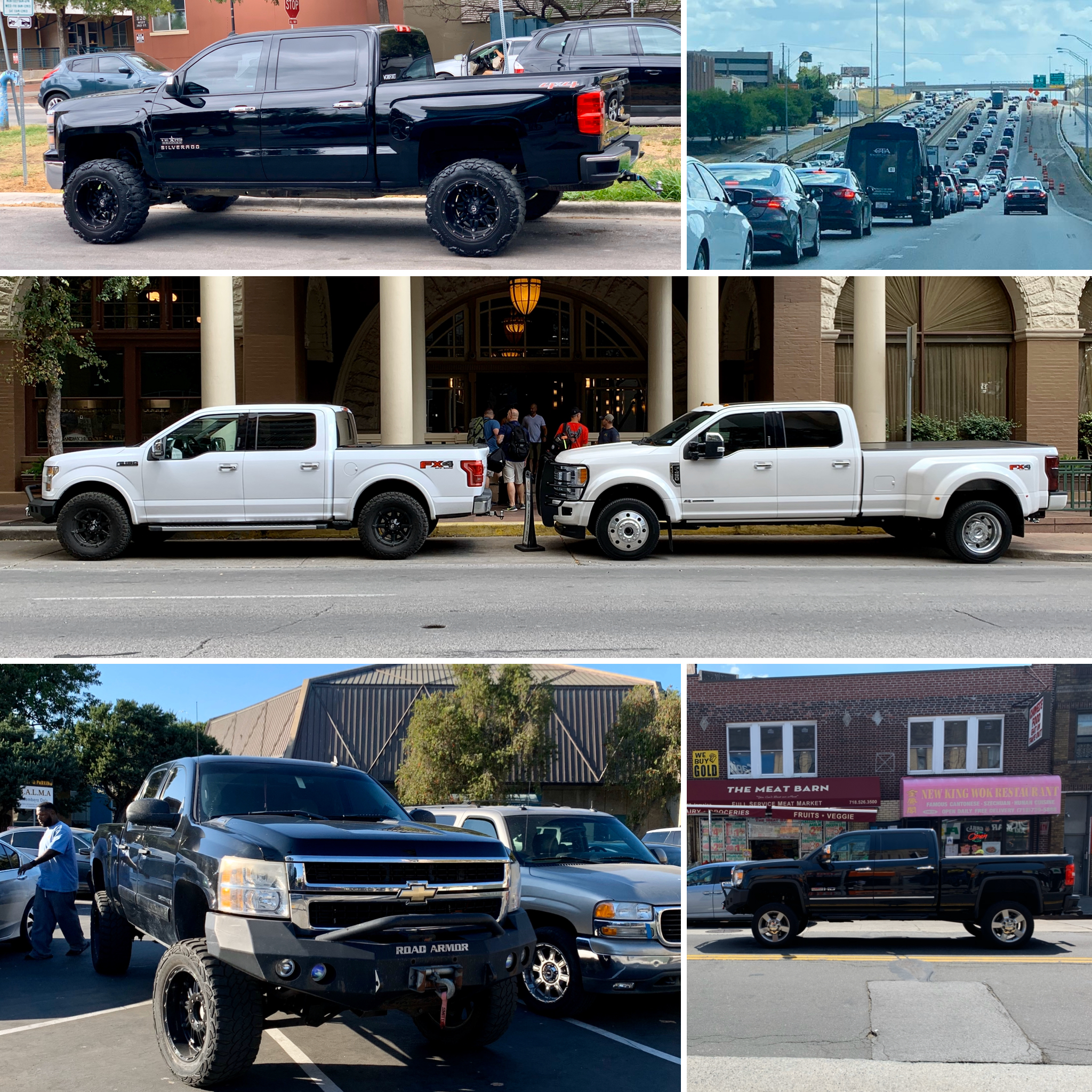
Creates this:

The above, in case you don’t recognize the reference, is an auto-centric non-place with an incredible infrastructure burden relative to its density. The generation who built this won’t be around to endure the incredible cost of its maintenance, which will either be funded through high federal/state taxes or crushing millages/assessments on the individual citizens who live here. “Freedom” to live where one desires is often brought into the conversation when sprawl and single-family housing is criticized, however, there’s nothing “free” about burdening fellow citizens with the cost of such development, or demanding that every public space be destroyed for the sake of one’s giant metal wheelchair, or a de facto car ownership requirement. By all means, choose live where you want, but let’s reconfigure the market so that true costs are reflected in those choices. Declaring the area pictured above as “freedom” is similar to one demanding that they be free to live in subsidized housing or to receive welfare.
Will glimpsing the occasional cyclist change anyone’s mind about driving or housing? Probably not immediately, but when citizens demonstrate that they can get from place to place without wrapping themselves in a 6,000 pound wheelchair and show their city that they want the ability to do so, change happens. More cyclists means more bike lanes, more awareness from drivers, more density and less parking. The most able bodied among us, especially, who want to see change, have a responsibility to get out there and ride, as it’s often the case that, while a person of stout age and fitness can make their way reasonably well through city streets, these streets aren’t yet safe enough for children, families or the elderly.
Choosing cycling (or walking, or transit, etc.) over driving is one small vote for human-scale cities and towns, for fiscally responsible and sustainable development patterns, for safe streets that value life over vehicles per hour, for mobility over isolation.
Cities are man’s greatest invention. The sprawling, auto-centric development patterns we’ve come to normalize in this post-war era are chipping away at our cities little by little. When you see someone riding their bike as a means of transportation in America, whether by necessity or choice, consider it the exemplar of all those little SUV window flags in action. Bike for your country.
